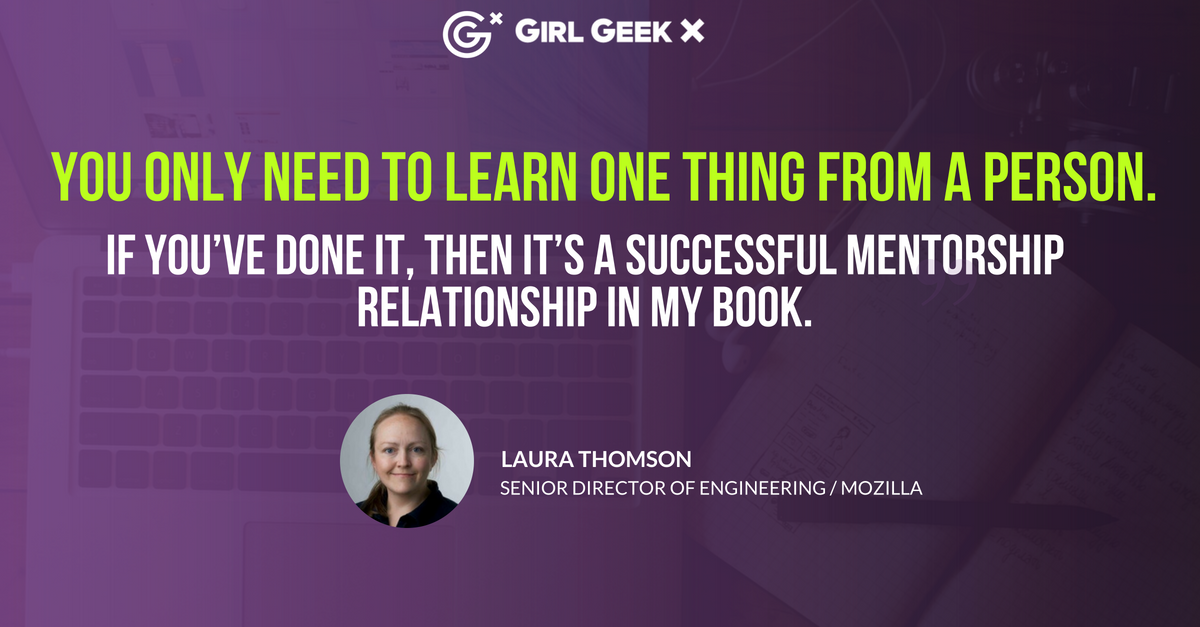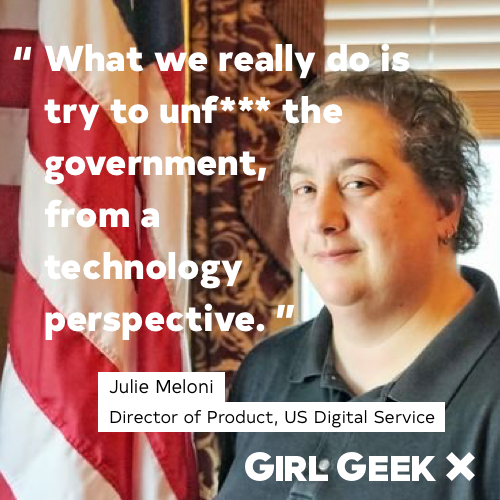Like what you see here? Our mission-aligned Girl Geek X partners are hiring!
- See open jobs at Guidewire and check out open jobs at our trusted partner companies.
- Read Guidewire’s blog post on a career in insurance: in it for the long haul.
- Does your company want to sponsor a Girl Geek Dinner in 2021? Talk to us!

Guidewire girl geeks: Priscilla Hung (Chief Operating Officer), Eileen Maier (Chief Business Officer), Lerk-Ling Chang (VP of Strategic Ventures), Sandia Ren (VP of Professional Services), Roopal Shah (VP of Go To Market Delivery) at the Girl Geek X Dinner held at Guidewire’s offices in Foster City, California.
Panelists:
Roopal Shah / VP, Marketing / Guidewire
Priscilla Hung / COO / Guidewire
Eileen Maier / CBO / Guidewire
Lerk-Ling Chang / VP of Strategic Ventures / Guidewire
Sandia Ren / VP, Professional Services / Guidewire
Transcript of Guidewire Girl Geek Dinner – Panel:
Roopal Shah: All right. Welcome everybody. We are so glad that you guys are here. My name is Roopal Shah. I’m the Vice President for Go To Market Delivery, which essentially is product marketing, sales enablement, business planning, and operations for our Go To Market functions. I’ve been with Guidewire for eight years. That hopefully tells you a little bit about what an awesome place this is to work at. Without further ado I would love to have each one of these ladies introduce themselves, tell us a little bit about what your role is, who you are, and how long you’ve been at Guidewire.
Priscilla Hung: Welcome, everybody, to Guidewire. My name is Priscilla Hung. I’m the Chief Operating Officer of the company. I have been with Guidewire for 13 years and two months. In Silicon Valley, that’s 1,300 years, as you know. I’ve been working in the Valley for about 30 years. This is, by far, the best company I’ve ever worked for. It shows because I’ve been here forever.
Priscilla Hung: My responsibility from a day-to-day basis, basically, is to make sure that the operation work, by design, but my direct responsibilities today include corporate strategy. That includes all the business development, market strategy, M&A, partners, product marketing, Roopal and Eileen’s team, and whatever that entails, including film marketing and definition of the market and product development. What else?
Eileen Maier: Film.
Priscilla Hung: Yeah. Yeah. I did alliances.
Eileen Maier: Influencing.
Priscilla Hung: Influence, like all the IT, IS, and security, cloud operations, customer success. I think that’s it. I really love the company. I love everybody here. I’m so delighted to see so many old faces here. I’m looking forward to have some conversation with you tonight.
Eileen Maier: Hi, everybody. My name is Eileen Maier. I am the chief business officer at Guidewire. I’ve been here 13 years. Today is my 13th anniversary! <clapping> I know! My role is chief business officer; I work for Priscilla. First things first, I do whatever she wants me to, but I’m privileged to lead the team that is actually the voice of the market. In understanding, you saw one of our customers talking about their market needs and what is it that they need to run their business. I have a team that is responsible for really understanding where those market needs are and to translate those into business opportunities for Guidewire. Where do we see a market opportunity by serving that customer’s needs?
Eileen Maier: Then, they work very closely with another member of Priscilla’s team, the product team, to realize that, to make it into something that we can bring to market. Then, I’m also privileged to have Roopal on my team because then it’s her team that does the Go To Market Delivery, so how do we translate that product or that solution into something that our sales people can sell so we can grow our business?
Eileen Maier: It’s been exciting and a wonderful journey to be with Guidewire. This is a relatively new position. I’ve been in it for about a year. I think that that’s something that I’d loved the chance to talk to you about, of transitions within your own company and how you can grow your career without having to change where you work. Okay. Over to you.
Lerk-Ling Chang: Hello, everyone. Can guys hear me? Is my mic working?
Roopal Shah: Yes.
Lerk-Ling Chang: Okay. Awesome. Okay. I’m Lerk-Ling Chang. I’m VP of Strategic Ventures here at Guidewire. My focus is on helping the company grow through acquisitions, through partnerships, and through venture investments. I’ve been with the company now for 16 years. That’s 14 years more than what I thought I would be here, so it does speak to the character of the company and what we love about the company. Encourage you guys to talk to the folks here who are wearing Guidewire t-shirts. Feel free to ask them why are you here and would love to share that with you.
Lerk-Ling Chang: I joined the company when the company was really small, 12 people, the company had just landed the first customer. Had just raised a first round of funding but didn’t have a product yet. They needed a product manager. I worked in one of the six co-founders at Ariba, a previous company where person that I worked at as well. He reached out to me and said, “Hey, would you like to join this startup of mine?” I was kind of in the middle of a transition. I ended up joining. Ken and I product managed the first product. Actually, I worked with Sandia on that one. A couple years later, led up the development of a second product, PolicyCenter. It’s been an exciting journey.
Lerk-Ling Chang: Now, I’m focused primarily on acquisitions, partnerships. Then, in the last few months, I’ve picked up the lead for our venture investments.
Sandia Ren: Hi, everyone. Is my mic on?
Roopal Shah: Mm-hmm (negative). No.
Sandia Ren: Hi. I’m Sandia Ren, and I’m a vice president on our professional services team. We’re the team that goes out to customer sites and helps them implement our product and use our products. We’re the ones who get to travel. I’ve been with Guidewire for fifteen and a half years, so a little less than Lerk-Ling. I actually started as a software engineer. Yes, she was my product manager. I wrote unit tests for our very first product. Now, I’m Vice President of Professional Services. I would love to tell you about that journey. I’ve been very grateful to Guidewire for the opportunities that I’ve had.
Sandia Ren: These days, I look after our specialized consulting teams. These are the teams that work on our products outside of our core systems. This includes our data and analytics products, our digital products, underwriting management, and then competencies like upgrades and testing and infrastructure, all the stuff that people don’t like to think about so that’s in there, the specialized umbrella.
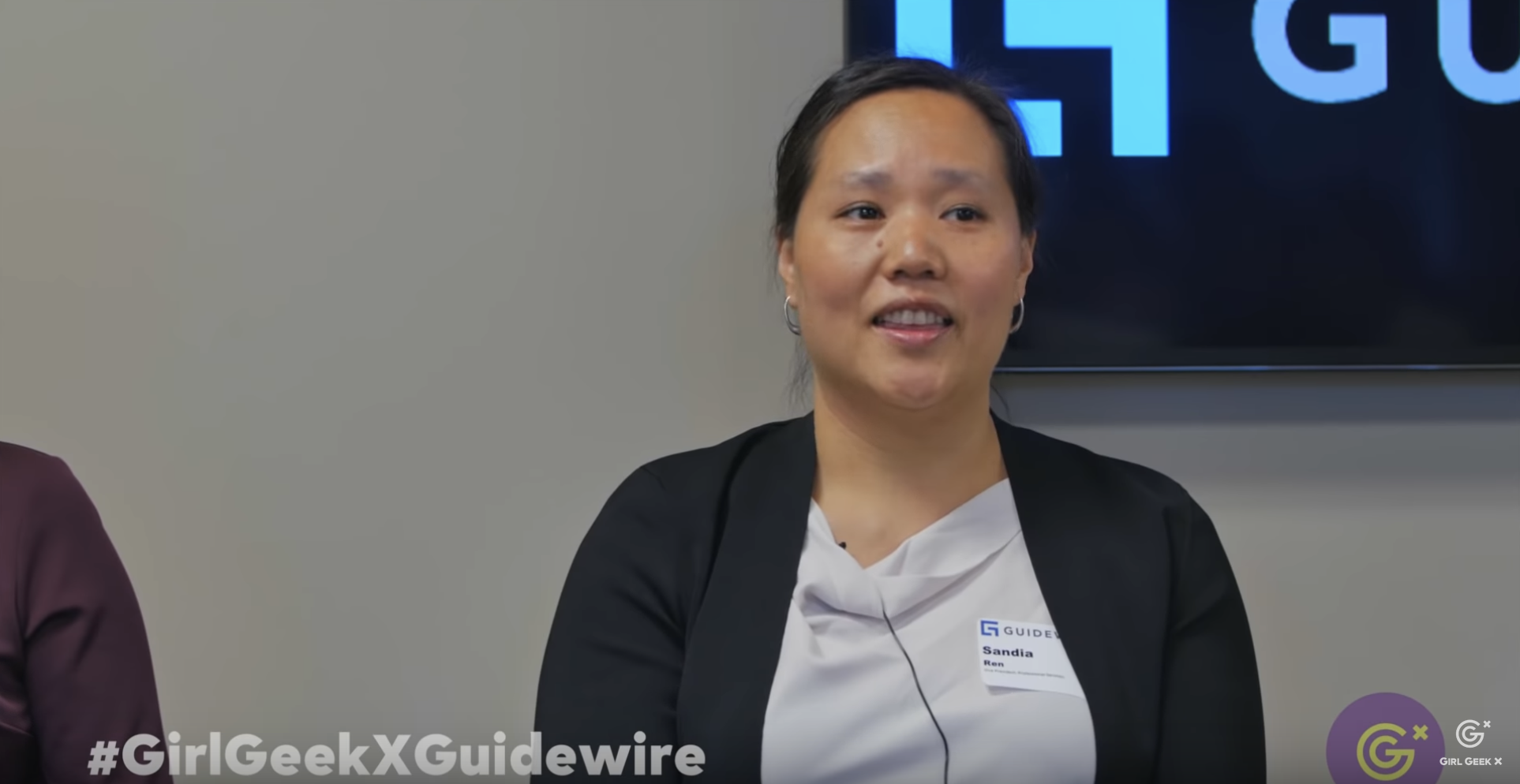
Sandia Ren speaking at Guidewire Girl Geek Dinner.
Sandia Ren: Then, I also look after what we call the Guidewire Services Center. These are our delivery centers around the world that have lots of teams of consultants who help our customers implement and deliver our products remotely. We have four offices now. Our largest is in Dublin, Ireland. Then, we have a team in Pennsylvania. It’s our US team. Then, we also have a team in Madrid, Spain. Then, we just opened an office in Malaysia.
Sandia Ren: For full disclosure, I just got off the plane from Malaysia. If it sounds like I can’t get my words out, that’s my excuse for tonight but I do certainly feel very privileged that it’s my job to travel around and meet just exceptional people around the world who all share our values and are committed to the same goals and our customers. Thank you so much for coming. It’s really exciting to be here.
Roopal Shah: Okay. Awesome. Thank you for that.
Roopal Shah:Let’s start with our first question and this is to all of you. I would love to get your perspective on insurance, specifically there’s a lot of talk about insure tech and what a pivotal time this is right now. What are your thoughts on that? Do you think it’s a pivotal time and what sort of skill sets do you think insurers and insurer tech companies are looking for right now? Anybody want to take that?
Eileen Maier: I can’t speak unless you give me your mic.
Roopal Shah: There you go.
Eileen Maier: I now have control. To rephrase the question, is this an exciting time in insurance? I would say, “Absolutely.” We serve the insurance industry. We are an insurer tech. Within the walls of Guidewire, I’m just so excited because every day, I get to talk about innovation.
Eileen Maier: When I started 13 years ago, today, anniversary, innovation really meant can I improve my business processes? Can I innovate on how I do my business and run my core systems better? That’s still true today. You can see the benefits from that video that we looked at not too long ago but innovation is transforming the industry. When you look around a disruption, it is absolutely impacting the insurance industry. It’s disrupting the way that they sell their products because people are expecting a mobile experience. They really don’t want to buy insurance through a broker. They actually don’t really even understand it. People are looking for insurance actually more associated with the service.
Eileen Maier: I’m sure everybody here is an Uber user. Not too long ago, I got an email in my inbox from an Uber saying, “Hey, with your app, you can rent a car now.” Actually I’m going to rent the car. I’m not even going to think about insurance because insurance is bundled in with that service. We’re thinking every day about what’s disrupting and transforming the industry because we don’t want to deliver products that they just need today. Certainly, we’re doing that. We want to think about what are the products that they need to deliver in the future?
Eileen Maier: I think that if, going back to the second part of your question, what are insurers looking for? They’re looking for creativity. They’re looking for innovation themselves. They’re looking for ways to do things differently because they really don’t want to just continue to do what they’re doing today.
Eileen Maier: Okay. Anybody else want to take a swing at that?
Lerk-Ling Chang: Yeah. I can chime in. I think people can hear me. Insurance is really changing really quickly. In the last five years, it’s probably changed … If you talk to anybody in the industry, they feel like the change has really come at a much faster pace than ever before.
Lerk-Ling Chang: It’s really driven by three things. Eileen talked about some of the things that are coming from consumers. You and I, we all want different things from our insurance companies than we ever did before but it’s also coming from the insurance companies themselves.
Lerk-Ling Chang: I remember 15 years ago, going onto the first customer visit and seeing people still using mainframe systems. It’s shocking but that’s actually a very common system that people still use. When insurance companies are still using that, they can’t actually deliver the kind of service they need to. It’s not because they don’t want to. They’re just stopped by doing that. In that sense, it’s really an exciting time for companies like Guidewire, who have solutions that can help insurance companies provide better service to their customers. That’s been a lot of also additional investment into the industry that then, at least … In the P&C, Property and Casualty technology space, in last year, for example, there’s been a billion dollars of venture funding that have gone into the space. That’s been a lot of startups. We’ve been the beneficiary of that, being one of the leaders here.
Lerk-Ling Chang: The industry has seen a lot of change and insurers themselves are looking for new solutions. It’s one of the best times to be in the industry right now.
Sandia Ren: I thought I’d address your question about what I personally think about insurance. I’ll be honest. When I started 15 years ago, I just followed good people to Guidewire. I didn’t really think too much about the domain or even the product that we were working on, but over the last 15 and a half years, I’ve definitely developed a true, very strong appreciation for what insurers try to do. It’s been amazing to see it evolve over the years but certainly we’ve seen a lot more when it comes to natural disasters.
Sandia Ren: I’m from Houston. We went through Harvey last year. That really hit home when I was hearing my neighbors and that was all that the talk was about in the neighborhood. It was claims and all these terms that I understood. When being in professional services, what I love about it is I get to go out and I get to meet with our customers and understand their business goals. Their business goals are about how to help people like you and me when we’re in our biggest time of need. That’s pretty awesome.
Sandia Ren: In the beginning, we used to say, “Well, insurance isn’t glamorous,” and whatever. We didn’t talk about it too much, but actually I think insurance is awesome. It’s really meaningful. I just wanted to share that perspective because I don’t think it’s something that you really realize until you think about it. At least, it was for me.
Eileen Maier: I actually wouldn’t mind building on that because it’s also the industry itself has changed. One of the more recent acquisitions, the most recent acquisition that Guidewire made was with a company called Cyence. It really is representative of how the insurance industry has shifted because 13 years ago, there wasn’t the need for something called cyber insurance or cyber risk but now there certainly is. Innovation and technology has driven, they actually created a new risk for us.
Eileen Maier: This is really incredible because what Cyence does is they have created a data engine that allows them to sweep up massive amounts of data so that they can use algorithms, detect where cyber risk is. This is completely different type of insurance than the property and casualty insurance that you use to insure your car.
Eileen Maier: I think that there’s this dynamic change within the industry itself because what is an insurable risk or what is risk itself is changing, which means the needs of consumers or businesses is changing and the market has to keep pace with that. The times around us ourselves is actually making it a dynamic time for the industry.
Priscilla Hung: Yeah so maybe I just really briefly round out. I think the ladies will touch on a lot of points already, pretty complete but just a few words. I echo Sandia’s sentiment. When I joined Guidewire 2005 and I joined 100% because of the founders. I’ve known four of them from my previous job. I had no idea what insurance industry is. In fact, when Marcus, our CEO co-founder call me and say, “Come join us,” I was like, “Why do I want to work for a company that serve the insurance industry?” All I thought about is I have to write money to them and when I have a crash, that it takes them a long time to pay me.
Priscilla Hung: But it’s a little bit of a learning curve for me but very, very quickly I have completely falling in love with this industry because you got a preview of some of the videos that you’ve seen but genuinely, our customer, the insurance carriers, they are generally full of people that spend a life and their career in making people whole. They are learning every day and trying to respond to the market and is an inflection point because it’s only very recently that all of us spend all our waking moments looking at devices.
Priscilla Hung: This morning on Today … I don’t know whether you guys watch morning television. I live by them. It’s one of the morning news. It says that an average person I believe is an adult. It didn’t say age group. It says that it spent on the average of 11 hours on electronic devices and between the age of 50 and 65, 13 hours. I don’t know how many hours people sleep but imagine that you spend so much time.
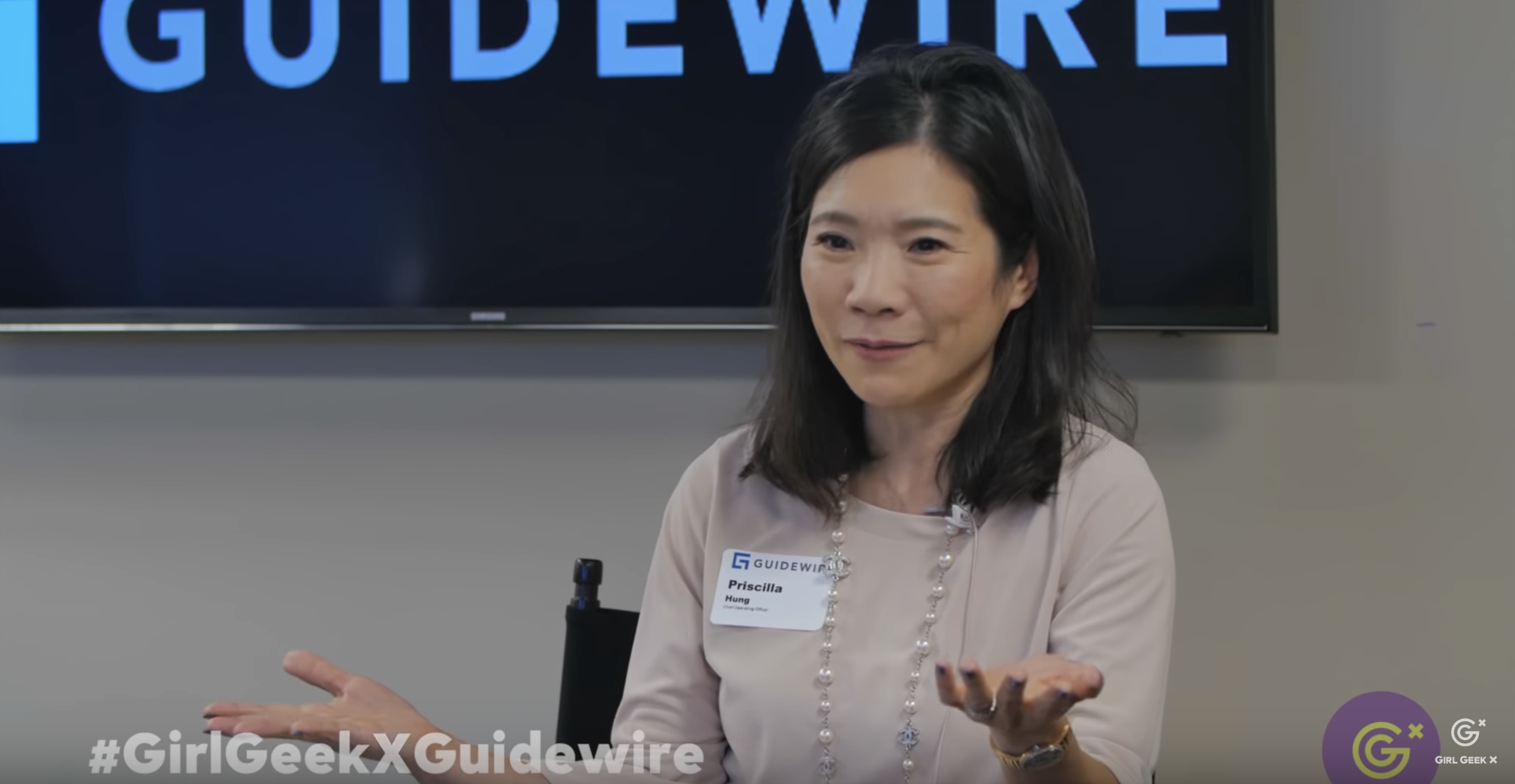
Priscilla Hung speaking at Guidewire Girl Geek Dinner.
Priscilla Hung: People don’t talk to each other anymore. My husband and I were texting each other the other day. I was like, “We have to stop this.” What the insurance company is trying to do is they want to understand this pattern. They want to understand how you live now because in the past, older people like me buy insurance, they call an agent and they’re all, “You fill in the form,” but nobody talk to people anymore. Most of you don’t have a landline. It is to response to the market, respond to this really rapid change because of what technology has come to play. I’m really proud to be part of this team and provide enabling technology for these insurance carriers to respond to your needs.
Roopal Shah: Awesome. Is my mic on? Can you guys hear me? Oh! There we go. All right. Okay. Let’s switch topics a little bit and talk about careers. What I would love for each of you to tell us a little bit about your career progression, how you got to here, if you made any calculated moves, if you had sponsors, mentors, just tell us a little bit about your journey to where you are?
Priscilla Hung: Me first? Okay, sure. My career journey. You might expect me to say, “Oh, you know, you must plan, you degree that you study and you plan your steps.” Absolutely negative. In fact, I go completely opposite side. For those of you who were raised by Asian parents, I’m sure that you appreciate what I’m talking about. My parents wanted me to be a doctor or a lawyer or a doctor or a lawyer, but especially I was pretty good at my grades when I was young and whatnot but I’m terrified of blood. My grandmother said, “Don’t be a lawyer because you will have to represent bad people.”
Priscilla Hung: Any case, so those path are gone. I said, “Meeny meeny meeny moe. So, what I do?” I ended up picking an engineering degree. It’s actually by elimination as opposed to plan. If you really asked me what I wanted to study, I want to be artist. I was a trained ballerina. I play pianos. I was a performer. I wanted to be artist. My parents are, “No, no, no, no, no.” You know how it goes.
Priscilla Hung: I got a degree that I really didn’t want to go for. Then, it’s like I go for a job now. I really stumble into … I finished my degree in the East Coast. I came over here because of a boyfriend. Two months later we ended. That was like, “Okay. All right. I need to look for a job.”
Priscilla Hung: It really, completely out of the blue, I got a call from a friend from high school who worked for Oracle. Oracle, at the time, in 1989, was a very tiny company. They were not in the Redwood Shores, up on Belmont Hills and said, “Come work for Oracle.” I was like, “Why to work for a database company?”
Priscilla Hung: I went through an interview that basically, in hindsight, if I were interviewing me when I was back in 1989, there is zero chance I will offer this girl a job because the interviewer asked me … I’m sorry. Am I running out of time? It’s a pretty long story. It basically is saying that, “So what would you like to do? You have an engineering degree. Would you like to be an engineer?” “Absolutely not.” I was like, “Okay. So, what do you want to do? Do want to be marketing?” “What is marketing do?” Show you how it goes. I thought, “Okay. You got good grades. You know, I’m going to hire you.” That’s when I started in 1989 at Oracle.
Priscilla Hung: In fact, I hop many, many jobs in the first 10 years because I actually didn’t really want to be in the discipline. I want to be an artist, remember? I hop around. I didn’t have a compass but I was fortunate in my career in the last 30 years that I ran into two people, both of them are my manager. Both of them saw that I’m someone that could be cultivated. I followed my first manager to three jobs. I finally, many jobs later, I landed at Ariba.
Priscilla Hung: I met someone that really wanted to develop me. He hired a professional mentor for me. The professional mentor was a retired woman executive. She completely changed my life. She completely utterly changed my life by basically putting a program together, told me five things I need to change, including my voice. “Don’t squeak like this. Don’t talk like a girl, so you have to talk with a certain voice.” This is my work voice. The second thing is, you won’t believe this, is that you smile too much. Stop smiling. I was like, “Stop smiling.” It actually took me a long time to really understand why do I need to stop smiling?
Priscilla Hung: The third thing is when you’re in meetings, talk at least once, speak at least once. Don’t go to a meeting and be in complete silence because if you are complete silence, you become irrelevant. Even if you’re repeating what other people are saying, paraphrasing it. Just speak once, and how you dress, how you present yourself. Now, I forgot what the fifth thing is but it’s five things.
Eileen Maier: Write things down.
Priscilla Hung: Yeah. Sure. Yeah. Yeah. Those things really completely changed my life. I would have to say that my career really started to go somewhere after I practice what my mentor told me. Add, after Ariba, four of the founders actually came from Ariba. Is again because of people I join here. The opportunity that the founders created for me. I got an opportunity to talk, do a lot of things that I have absolutely no experience, zero experience. It’s not planned for. It’s not because I’m experienced. It’s all because you have a new problem to solve. I work very, very hard. I focus on what I need to do, drive outcomes and then, one good outcome lead to another good outcome.
Priscilla Hung: Also, in hindsight, because all the randomness, all the different flopping around. My career actually helped my current job today because right now, I have a pretty wide scope of responsibility. Many of those jobs I actually have done in the past, not because I planned it. I would just say that I didn’t go through the traditional way. I didn’t plan but it worked out. I think it’s because of people that honestly is people relationship I built and people that help me along the way.
Eileen Maier: Okay. Are you sure you’re done? I’m going to start my story differently but then I think you’re going to find some similarities between my story and Priscilla’s story. Wasn’t an artist but also wasn’t an engineer. I got an English degree. I remember telling my father that I wanted to move from accounting to English. That was a pretty difficult conversation, at least for me. He took it pretty well, but it was, when you get out of college and you have a Bachelor of Arts in English, you do struggle a little bit to say, “Where am I going to get a job?”
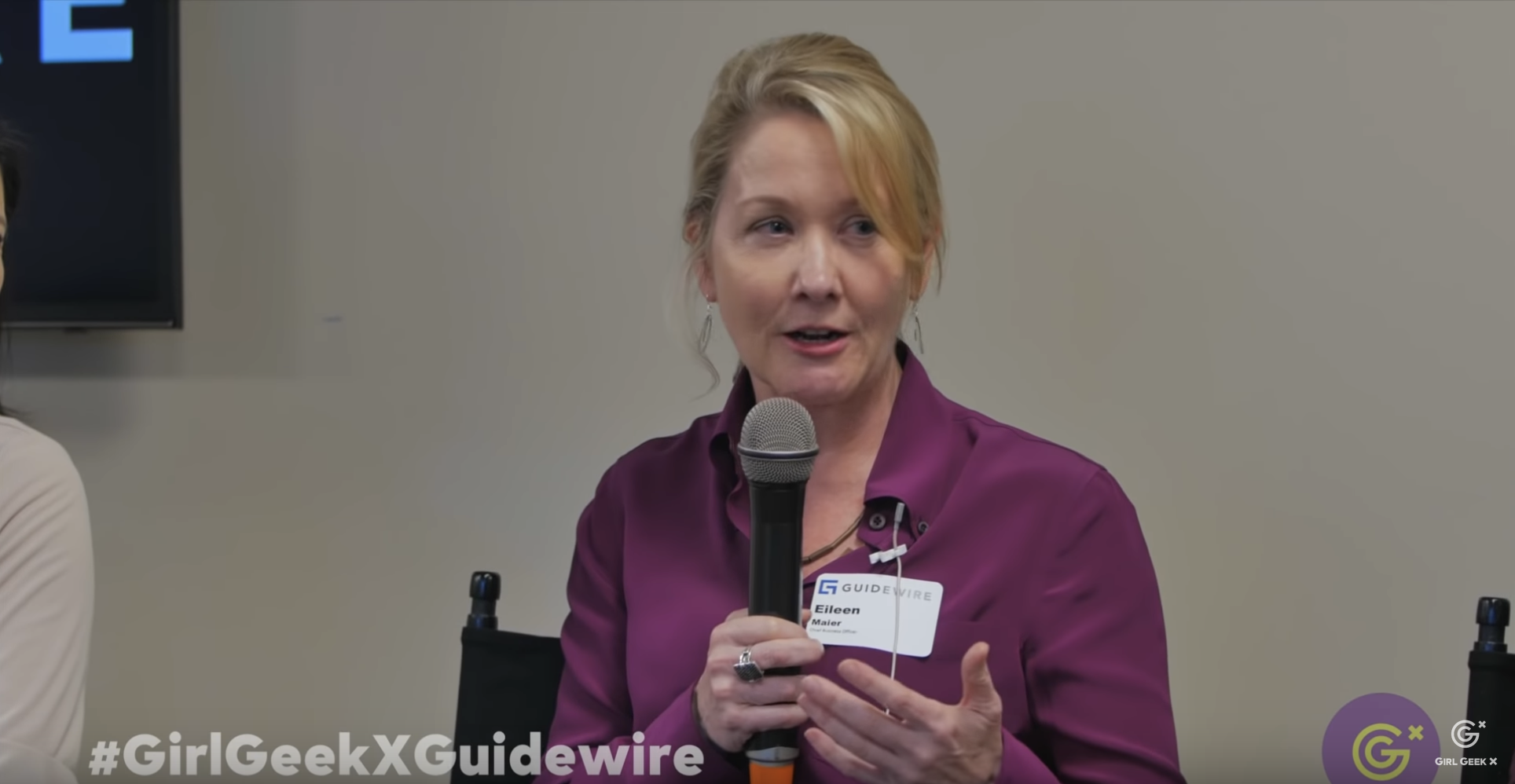
Eileen Maier speaking at Guidewire Girl Geek Dinner.
Eileen Maier: This is where I think this theme of two pieces of advice. Be curious and also be open to luck. I think my parents felt a little bit sorry for me. I’m trolling around, living upstairs. They’re like, “You need a job.” Again, be open to luck. Take advantage of favors.
Eileen Maier: I got an interview with an insurance company. Really, if you’re an English major in Liberal Arts, actually insurance is a place that will consider. That’s how I entered into the insurance industry. Then, the curiosity kicked in because I was curious about, “Well, what it like to be an underwriter?” I had no idea. Learned that trade. Also saw what other opportunities were available for me within that insurance company. It was Liberty Mutual Insurance.
Eileen Maier: I was living in Philadelphia. I got the opportunity to move up to Boston. I took a role in a training organization. Again, within the same organization exploring different opportunities, different interests. I really started to learn something about myself by trying different things, by being curious. Through that, I got an opportunity to go into risk management. I joined a consulting group. That required me to get an MBA. It’s like these things start to build on each other and you follow a path. There’s something that you do when you get your MBA and you’ve worked for an insurance company for 10 years. You quit and you get another job.
Eileen Maier: That’s when I left and I moved to PeopleSoft. This is where I entered into technology but, again, being open to luck, why PeopleSoft? How could they possibly even consider me? It’s because somebody I went to grad school with. I called her up because I just wanted to get some advice from her. I wanted to understand how she made a career transition.
Eileen Maier: By reaching out and having a learning conversation, she actually wagged her finger at me and said, “I know exactly what you need to do.” We all want somebody to say, “I know exactly what you need to do. Give me the answer,” but she was right. She turned me on to this profession I’d never even heard of. It was called sales consulting or sales engineering. It’s where you have this opportunity to help customers, you’re consulting with customers, you’re understanding what is the business problem that they’re trying to solve. Then, you say, “Oh, well. I have just the thing for you.” Then, you go into a product demonstration and you show them how this product that you have can change their life and transform their world. It’s a little bit of performance. It’s a little bit of teaching. It’s a whole lot of consulting. It requires a lot of courage and empathy. I loved that.
Eileen Maier: I worked at PeopleSoft for quite a number of years. We got acquired by Oracle. I went on that journey too but it was within a couple months that I moved out to the West Coast, another similarity, poor guy. Within two months of being out here, my phone rings. It’s somebody again that I used to work with. He had just joined Guidewire. He said, “Eileen, they’re starting this team. It’s really cool. I’ve met the founders. They’re doing something very different. It feels like PeopleSoft,” because that was a bit of a culture, a cult. He said, “But there is one thing you need to know. Mmm, they serve the property and casualty insurance industry.” He’s pitching that to me like you’re going to have to deal with that. I was like, “David, there’s something you don’t know about me.”
Eileen Maier: With Guidewire, it was bringing together 10 years at Liberty Mutual Insurance, a number of years. I won’t give it to you because then you can figure out my age, at PeopleSoft in technology. Then, I joined here in 2005 and worked with Lerk-Ling because it was PolicyCenter, the second product that I was able to go out and start to build the sales consulting organization.
Eileen Maier: Then, with so many of the opportunities, the same thing that Priscilla has spoken about and you’ll hear Lerk-Ling speak about it and Sandia as well is that just in a growing organization, there’s so many things that need to be done. You start building a sales consulting team. Then, you start building a global sales consulting team. Then, you realize we really need a demo team infrastructure so we need to build that. Then, we really need to enable our sellers better as we’re starting to scale the organization so you start to build that.
Eileen Maier: With a mission and a vision, you start to collect really good people around you. I’m so privileged. I’m humbled by the people that I work with. It really is this journey of curiosity but also being open to luck and go into learning conversations, curious to find out what you might hear but also be transparent with what you’re looking for because you might be really surprised. Somebody might be able to wag their finger at you and say, “I know exactly what you need to do.” Anyway, that’s my story.
Lerk-Ling Chang: We haven’t planned this, but my career, it merged there, was not planned. I didn’t set out to work in a software company. In fact, I didn’t even know that was there was such a thing called software product management. Graduating from college, I had an economics degree. Coming out of college, the two positions that people recruited for was investment banking and management consulting. I picked the one that I thought was most interesting, which was investment banking. Did that for three years. Went to business school. Didn’t hear about product management either. Didn’t want to do investment banking, so decided to do finance. Eventually decided that was not my track. When I moved out to California, I talked a business school friend.
Eileen Maier: Was it for a guy?
Lerk-Ling Chang: It was not for a guy. I was already married, so not for a guy but it was through a business school friend who was working for the startup in Mountain View. I had no idea what a software company was, no idea what even development looked like in a professional enterprise. He just said, “Hey! Why don’t you join this software startup? Got this cool health care tech, monitoring health system,” called Health Buddy. It’s like this cool, little system. “They needed someone to help them with product partnerships. Why don’t you come join? You have investment banking. They’re going to need help us figure out how to put deals together.” I was like, “Okay. Great. Let’s go figure it out.” Anyway, I joined. Pretty soon after, I realized the product was not quite ready for any partnerships of any kind. It needed a lot more work in order to support and not any partner of any sort.
Lerk-Ling Chang: Then, I started talking with the product team and said, “Hey, you know, it needs this, this, and this.” There was only one product manager, who was completely overwhelmed with work. He wasn’t going to have any time to do it. I just ended up deciding to write up all the requirements that I thought would be needed for the product. I didn’t know this was product management. I just started writing out learning requirements, step-by-step flow of what I thought someone would need. Then, just started socializing it with the head of the product team. This guy said, “Hey! Do you want a job? Do you want to be our second product manager?” That’s how I fell into product management. I did that for a bit.
Lerk-Ling Chang: Then, got a job at Ariba after that, where I ended up working with Ken Branson, who is one of the six co-founders here. That’s how I end up here at Guidewire. I did product management at Guidewire for, I guess, it’s probably about 12 years. Then, decided to switch out of that role into something completely different, focusing on corporate strategy.
Lerk-Ling Chang: What that means initially was two things, strategic partnerships and then second is acquisitions. It’s been fun doing that because I worked on acquisitions as an investment banker before, but, at that time, you run numbers. You say, “Hey! You can cut cost here. You can add here. You can the increased revenues by 10% 20%,” but you don’t really know what it looks like.
Lerk-Ling Chang: Now, I’m on the other side of the table where we have to go through systematically to understand, “Hey, can we really grow revenues, work with all the different teams around a company to understand how to plan an integration and make sure the acquisition actually comes to fruition?”
Lerk-Ling Chang: I’ve been involved in all of the five acquisitions that we’ve done. It’s been a really interesting experience seeing that. Now, I’ve had the opportunity as part of this to now lead up our venture investments, which are going to be starting out and doing a lot more of.
Lerk-Ling Chang: It mirrors the careers of these two ladies here. It’s not planned at all, taking the opportunity, taking the initiative when you see something that’s a problem that you think you can help fix, taking the initiative to suggest solutions, and then working with people to see if that can actually come to fruition. That has helped quite a bit.
Lerk-Ling Chang: But the other thing, too, is finding people along the way that have helped me. For example, Ken was instrumental in bringing me here but even in my first job in investment banking, I had a senior managing director who I was able to work really closely with. She let me run a bunch of her deals, which is pretty unusual coming out of college.
Lerk-Ling Chang: Then, now I get to work with Priscilla and Eileen. You get different opportunities and you find people who can help support you and give you new things to do.
Sandia Ren: Okay. Going to be the same themes. Tells you something about Guidewire, but I remember looking recently at my high school yearbook. It has the question like, “Where you going to be in 10 or 20 years,” or something like that. I said I was going to be an electrical engineer and I was going to have two kids. That’s totally wrong. I am past 20 years so you can figure out how old I am but I have a three year old, and I’m not an electrical engineer.
Sandia Ren: Certainly my life didn’t quite turn out the way that I thought it would be, but I did start out on that path. I did get a computer science degree out on the East Coast. Then, I came to California. I actually followed the gold rush because that was during the dot-com boom, but I caught the tail end.
Sandia Ren: When I joined the company that I joined, I think the stock price was at 200. When I got the offer, it was 200. When I actually started, it was like 20. I caught the end so I had to work.
Sandia Ren: Anyway, actually and it’s all about people connections, too. The reason that I actually ended up at that company was because of somebody named Charlie Lee, which some of you guys know from the industry. He invented Litecoin and all of that stuff. But Charlie and I were in school together. He said, “Hey, I interviewed for this great company. You should really come and meet with them.”
Sandia Ren: I met with them and my hiring manager turned out to be the future CTO of Guidewire. I worked with him and had fantastic mentors there who taught me how to be an engineer. I think in school, you learn how to code but that’s pretty much it. I had a mentor who taught me how to work with the requirements, not to just build whatever was given to you but take a step back, understand why and make sure that you feel like this is the right way forward. I don’t think that’s something you learn in school. Just the start of learning from many wonderful mentors along the way.
Sandia Ren: Anyways, really, it’s when one door closes, a window opens. As was happening often there, the development at the company that I was at because they had gone from 200 to 20. The team was getting smaller and smaller. They eventually decided to outsource everybody to India. I was told that I had six months left.
Sandia Ren: I kid you not. That very day I had lunch with former co-workers who had left. They said, “Hey, Guidewire is hiring. Are you interested in coming to meet with us?” Sure. It was my old team, my old hiring manager and all of my great mentors who were over there. That’s how I ended up at Guidewire. Like I said, I wrote unit tests for our very first version of our product.
Sandia Ren: Then, I was a software developer for a while. I thought, “Yeah. This is the path I’m going to do,” but that lasted probably just for three or four years. That was when I started thinking, “Do I want to do something different?” I got enough…it was starting to feel a little routine, so thought maybe a different industry, maybe just needed a change. I actually started looking outside of Guidewire.
Sandia Ren: Then, I remember what pretty much changed my life, it was an email. Again, full disclosure. I am a huge Red Sox fan, being from Boston, so huge Red Sox fan. The year was 2004 and our Liberty Mutual had just gone live with our first product. Our head of professional services said, “They’re so excited. They’re as excited about the go live as the Red Sox winning the World Series for the first time in 89 years,” which is impossible but that’s what he said.
Sandia Ren: A light bulb went off in my head that, “Hey., maybe I can stay at Guidewire but do something different here. Maybe I can move into the services team and it would also give me the opportunity to move back to Boston,” which is what I had been hoping to do.
Sandia Ren: At that time, we were still pretty small. It was 2005. I went to Ken, and I said, “I have this really crazy idea.” I told him about it. Actually, I was working on PolicyCenter then. He said, “You know, it’s not a bad idea. You built PolicyCenter, so you can go implement PolicyCenter when we sell it.”
Sandia Ren: I learned really quickly how hard that was. Lots of lessons learned there, but he was really open to it. Again, just I think that is just a leadership style that I want to emulate. It’s being open to people’s ideas. I really appreciate it he didn’t say, “You know, that’s crazy.”
Sandia Ren: That really kicked things off. I found that consulting professional services worked really well for me because I really like to understand the business side. But I still got to use my technical skills in helping our customers come up with solutions that would work for them.
Sandia Ren: Then, from there on just within Guidewire, I was open to opportunities. I had managers who had crazy ideas, too, and for whatever reason would let me help them implement it. I think there are many times throughout my career where I was given a role that we could have easily hired for externally and would have found somebody who had been doing it for 10, 15 years to do a really good job at it, but no. They let me have a shot at it. I don’t know why but I’m really appreciative of that. I think it’s a big part of our culture as you’ve probably heard throughout, what the other ladies have said.
Sandia Ren: Now, as a leader, as a manager, that’s what I try to do as well. I’m so grateful for all the different roles that I’ve had because it’s given me a really good perspective of the business. That’s the type of career path that I want to give to my team as well. My team really focuses on growing people, development. I highly encourage transfers. We transfer a lot of people between consulting and product development, even over to sales consulting and education all over, but I think it’s a win-win for both the company and for our team member. That’s my story.
Roopal Shah: Okay. All right. Hopefully, that gives you some insight into how these ladies got to where they are. I’m going to do a quick hit, just because I want to make sure we have time for these guys to ask questions.
Roopal Shah: We’ll start with you, Eileen. You’re known for your presentations. Do you have any tips, tricks, anything to share?
Eileen Maier: Sure. No pressure. I’m going to tag off with something that Sandia said because she said, “Start with why.” If you’re doing a presentation, you’re thinking about a presentation. First, have an answer to that question: why am I giving this presentation? One of the questions that I’d like to challenge people with is what is going to be different in the universe after somebody sits through your presentation? So why?
Eileen Maier: In articulating that why, you really want to define for yourself where is the audience starting from and then where do I want them to end up? Then, I can get into a lot of techniques of how you tell that story but I think the most important thing is to also remember that it’s not about you presenting it. I’ve got this idea. I want this idea to get across. I know why I’m doing it but I’ve got this audience that I need to pitch it to. You’ve got to spend a lot of time thinking about who is my audience? Why are they coming here? Why are they listening to me? What do they want to get out of the presentation? What do they want to get out of this meeting? How are they hoping that their world is going to be different after they listen to me?
Eileen Maier: I think that that’s where a lot of people fall down because people get so in their head about presentations. They’re in their head because they’re thinking about themselves. They’re like, “I’m going to embarrass myself,” or, “I’m going to put myself out there and people are going to be judging me.” Actually, they want you to succeed. They’re going to be judging you if you get up and you actually waste their time.
Eileen Maier: Spend a lot of time thinking about why you want to give the presentation and then spend a lot more time thinking about your audience because you want to craft your message at a place where they can meet you because good communication isn’t just about speaking good words. It’s about speaking words in a way that they’re going to be heard. That’s really, to me, the key of a great presentation.
Roopal Shah: All right. Thank you. Priscilla, this one’s for you. You’re on the board. I know, for a lot of people, that’s a goal, for whether it’s to get to the highest rung on the ladder or to actually make a big difference. Would love to just get your perspective on what it’s like and just share with us.
Priscilla Hung: Yeah. Interesting. I think that when people say, “I would like to sit on boards as a goal,” I find it very interesting because I will always ask the question, “What do you think board members do that you want to sit on boards?”
Priscilla Hung: First of all, let me show you what board members actually do. Board members have fiduciary duty for shareholders and also as an advisor to the management team but primarily as a CEO and a CFO and key executive of the company. They show up in board meetings four times a year typically and a little bit more, if you are participated in some varying committees, like compensation committees or audit committees, so on and so forth. Of course, you get compensated for that.
Priscilla Hung: When people say they want to sit on boards, you have to understand just like why do you want to be in a certain job? You want to know the job description. It is work and it is work that it will be fulfilling to you, if you want to be in that role, like you want to be an advisor and you truly, genuinely want to help the management team.
Priscilla Hung: Of course, board members are a prestigious job but the thing is, if the goal of being on a board is…it’s a more of a fame or ego-driven goal, then you would not be a good board member and people can smell it because you got to be interviewed to get on a board as well and management team will seek out attributes from you or your vibes, then, “Why do you want to sit on their board,” and how do you help them?
Priscilla Hung: I would say that people typically seek you out as board members as a reflection of all the hard work you put into your career. It’s typically is the experience that you built, the reputation you built that people will come to you and say, “Hey, you have worked in all these company. You have these experiences. We have a company that, at this stage, would like, it would be lovely if you can share your experience and guide the principals along.” That’s you how you sit on a board.
Priscilla Hung: It’s very difficult to set that as a goal because it’s not something you apply for but again is if you focus on your work, you drive, focus, excellent work product and I would say that sitting on boards is a reflection of all the hard work you put into your career.
Roopal Shah: Thank you. It’s working. Thank you for that. Okay. Lerk-Ling, so you’ve been here for 16 years. Can you share with us or what it’s like to work for a mid-sized company versus a startup and any perspectives?
Lerk-Ling Chang: Sure. When I joined Guidewire, there were 12 people. It’s actually the second startup I’ve been at. I was at a previous startup that was not quite that successful. In fact, similar story. It was dot-com bust years, that raised $20 million and then effectively let 75% of the staff go within a year of raising that money. It was those crazy times. I’ve seen the whole gamut of startup all the way through the mid-sized companies.
Lerk-Ling Chang: Some of the things to think about if you’re thinking of do you want to work on a startup? Should you work at a startup? A few things, a couple things. As a startup, you definitely get a breadth of experience across many, many things. In the very early days at Guidewire, I was not only the product manager, I was also the UI designer. I was also the product marketing person, also did the sales demos, also did desk manager sometimes, was also the scrum master sometimes in the QA. The list goes on. Y
Lerk-Ling Chang: ou just do whatever you need to because they’re just not that many people and there’s stuff to get done. The customer is waiting for you. You just do whatever you need to get done. Great experience. A lot of breadth and something you get a lot more responsibility but it’s also very exhausting. You can imagine. Which one do you prioritize? It’s fun whereas as the company gets bigger, your job has to get more focused. It frees you up to actually focus on the things that are most important.
Lerk-Ling Chang: For example, in product management, personally I was very glad not to have to do demos anymore when Eileen joined, for example. I didn’t have to fly to go. It’s too hard to focus if you have so many things to do.
Lerk-Ling Chang: As the company grew larger and you have people who are much, much better at doing demos than I was ever at, I could then focus on being a good product manager. I focus on really understanding what makes the design, what things we should put into the product and how best to do that. That’s one example.
Lerk-Ling Chang: The other example is about, the other thing to think about … Sorry, but this is mid-sized. I talked about the company going downhill, the other startup that I joined. That was, I guess about 20 years ago, but very few people know that actually Guidewire also went through tough times. We actually had a layoff. I can’t remember when that was. You remember that? I don’t remember that. It’s long gone, but very few people know that. Actually, Sandia probably remember that. It was not great. We had to pull the product out from the market, not great.
Lerk-Ling Chang: As a startup, you’re still trying to figure out what the fine line is. You may have gotten one success but to actually get beyond that first few customers, that jump to the next level customers is actually not that easy. Being able to do that successfully is actually a lot of work. It’s a lot of …
Lerk-Ling Chang: I did a lot of things that as a typical product manager in a larger company wouldn’t get to do but it was also incredibly, very stressful. Just those things to think about.
Roopal Shah: Okay. Then, Sandia, I’ve got a question for you. I know one thing that you’re doing is leading this initiative called GROW. Can you tell us a little bit about that and what inspired you to start that?
Sandia Ren: Yeah, sure. GROW stands for a Guidewire Recognizes Our Women. It is an initiative that we have within the professional services consulting team that is focusing on our female colleagues and how to provide better support for them. I think we know the reason for things like this is because we don’t have that many females in the tech industry. Then, you add on IT consulting and then that number really dwindles even more. It’s something that’s been in the back of my mind. Then, certainly, of course, their current events have raised it to the forefront as well, but I have to say it wasn’t really me. Actually, there are a lot of people on the services team, a lot of women on the on the consulting team, that I think we’re sharing the same sentiment.
Sandia Ren: We came together and our focus, again, is I think most importantly to provide a forum so that we can we can understand what challenges women face in consulting and in IT consulting. Then, hopefully figure out things that we can do to make it better. As part of my own research and development, I have gone to a women’s conference earlier this year. I found that just being within that forum and being able to talk to other women like me was a huge help.
Sandia Ren: To be able to hear that one of the most accomplished people in science felt the way that I do, which is a hot mess a lot of the times, was comforting to talk to other women. I see impostor syndrome right in front of me, like it’s yelling at me, but to talk to other women who also feel that way, that, “I’ve no idea of what I’m doing half the time but I’m going to figure it out.” It was really comforting to me.
Sandia Ren: That’s really what we want to do in the beginning is to at least is to provide that forum because I think events like this, it really helps me to be able to talk to other people who are in similar situations and realize that I’m not alone.
Sandia Ren: Those are the things that we want to do with this is to look at women in our consulting team. It’s hard with the travel, especially those who have families and who have kids that we want to be home with and see what we can do to make things better. Then, second, just as important, is to raise awareness.
Sandia Ren: Guidewire has a great culture. We have collegiality as one of our strongest traits but even so, I think there is awareness that can be raised about the challenges that women face. When I’d spoken to my male colleagues about this, they’ve been very receptive. I’m excited to see what we can do with this.
Roopal Shah: Awesome. Final question. Then, I would love to get some questions. Tell us your most embarrassing moment, professionally.
Sandia Ren: I’m glad you qualified that.
Roopal Shah: Who wants to start?
Priscilla Hung: I don’t have any. I can’t think of … Okay. You go. You go.
Eileen Maier: Where do I begin? It’s funny that you ask me the question, Roopal, about presentations because, actually, my most embarrassing moment actually comes from a presentation, so don’t do this. I’m working for PeopleSoft. We’re doing a product launch and we’ve got, I don’t know, five, 600 people at the Hilton up in San Francisco. It’s a big stage and everybody’s in the audience. I’m giving a demo. I’m doing it with my boss. I’m up on stage. I’m up towards the back. If anybody here has ever seen a product demo. Actually in the audience, you really can’t see anything. You have to use big, sweeping motions and so, “Up here, you know, you see blah, blah, blah and if you look down here,” and with one sweep of the arm, I fell right off the back of the stage. I was just gone. I was just gone. I’m all mic’d up. It’s a tuck and roll. I’m under the stage.
Priscilla Hung: Oh, my god!
Eileen Maier: The one thing that did happen that was actually good about this is that it was right before lunch. Now, everybody is now up. They were like, “Uh!” They’re just waiting because … I’ve got the mic on. They just start to hear, “Heh, heh, heh.” I’m giggling under the stage. I’m sure I’m in total shock. I come out from underneath the stage. I pop my head up. I think the really embarrassing part of the story is that, at the time, I had really short, bleached blonde hair. I think that’s really the more embarrassing part but they see this blonde head out on the suit, climb back up on the stage. I don’t even use the stairs. I just climb back up.
Eileen Maier: You don’t know what to do. I’m like, “Well, I guess I’ll just pick up where I left off.” I try to get back into it. I could just tell I wasn’t settled down, the audience wasn’t settled down. If you’ve been on a big stage like that and you’ve just got like these lights in your eyes, you really can’t see anything. I look out into the dark where I know people are. I just look at them. I pause and I say, “I wish I could say that was my most embarrassing moment.” They’re like, “Oh, okay.” I finished out the demo. Then, I think I went back to my hotel room and I crashed for a good eight hours, but I think from that it’s like just keep going. It can try to keep it out of your head and you just get it done. That’s one of mine.
Roopal Shah: Anybody else willing to share?
Lerk-Ling Chang: Mine is somewhat similar. We have an annual user conference. This was probably about 10 years ago. I was doing an intro to new things in PolicyCenter. I’m talking about all the cool stuff that we have been doing the last year, all the accomplishments. Then, talking about one of the biggest news that we had was a new partnership that we had signed that I completely blanked on the name of the partner. Completely, no idea. Silence for two seconds. It felt more like two minutes, right?
Eileen Maier: Mm-hmm (affirmative).
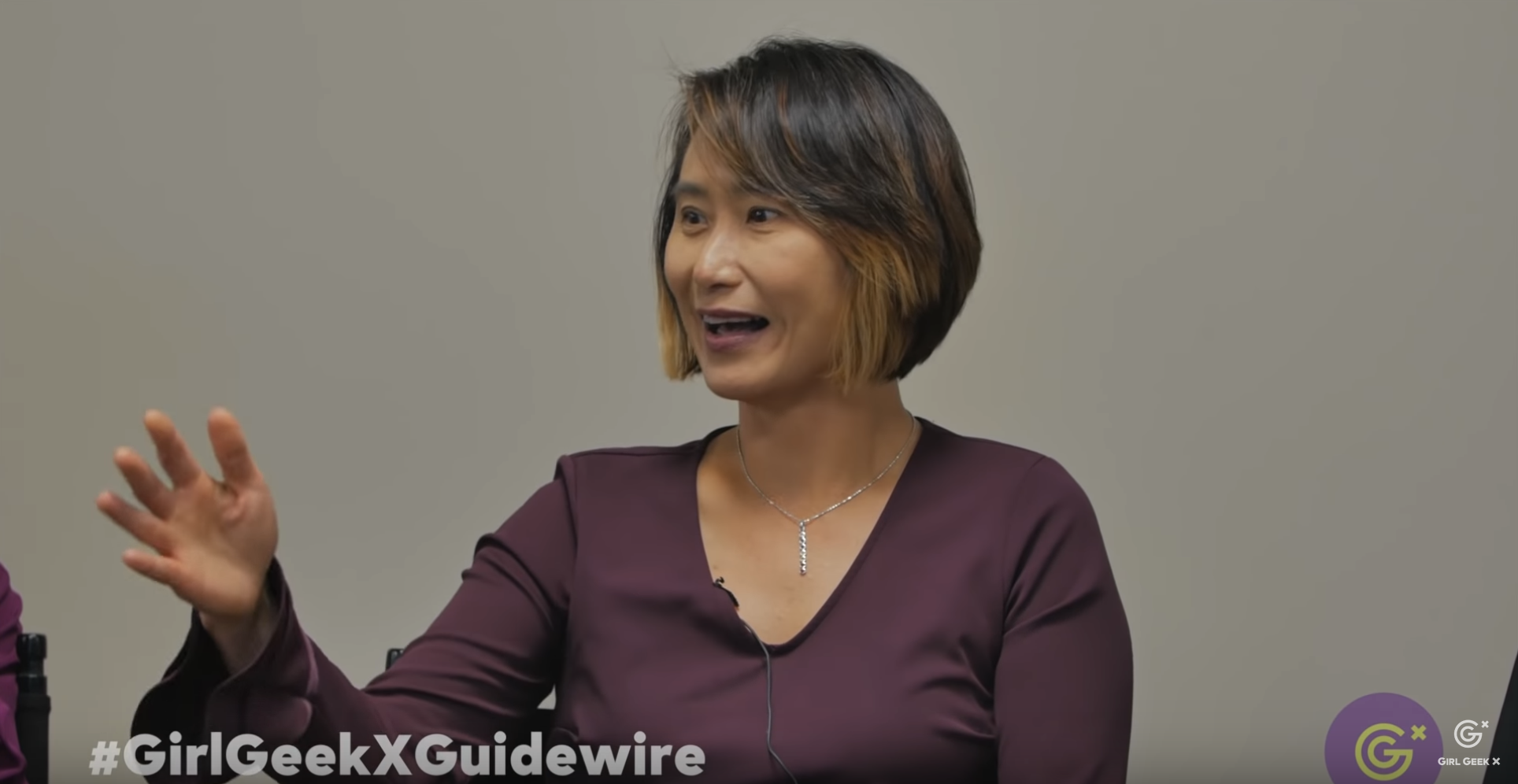
Lerk-Ling Chang speaking at Guidewire Girl Geek Dinner.
Lerk-Ling Chang: Luckily, someone from Guidewire shouted out the name for me, and I just try to go on. Lesson there is, as they say, just go on. We all have that moment. I guess the main thing is you just have to keep practicing and hope that your muscle memory eventually takes over. Mine didn’t, so just keep practicing. Things happen. It’s okay. We all live to tell it.
Eileen Maier: That’s right. You’re still here.
Lerk-Ling Chang: Yes.
Roopal Shah: Anyone else?
Sandia Ren: Mine’s not really funny, so I don’t know if it’s a great way to end, but, so in consulting, you get to meet all sorts of customers with different personalities and different thoughts about the way things should be. Anyway, I was involved, working with a customer. We had gone to do what we call an inception project kickoff. We had done that and then we had finished.
Sandia Ren: Then, what we typically do is we go back periodically to check on how … We do what we call health checks, which is to see how the project is going and check in with the team and check in with the customer and such. I guess either this hadn’t been explained to the big boss in charge or he just didn’t want to spend the money because I traveled there. I showed up. I was sitting there at my desk working away. He comes up to me. He just pretty much hovers over me and says, “What the are you doing here?” I just froze. I didn’t know how to answer that. I stumbled a little bit but eventually was able to say, “I’m doing a health check and these were the benefits of it,” and such.
Sandia Ren: He really didn’t buy into it. That was my last health check at that customer, unfortunately, but I think it was very awkward moment. But, now actually my coworker, who was there with me, he tells everybody as a joke because he thought it was just the most hilarious thing ever.
Sandia Ren: We can laugh about these things years later but I think, at least for me, the lesson learned was that actually I think he was trying to intimidate me. I thankfully recovered and just have confidence in what you’re doing. I got through it.
Priscilla Hung: I really don’t have anything good thing. Maybe just like a little while ago, I forgot what was the fifth thing that my mentor said but now, in hindsight, the whole time of thinking what’s the fifth thing. Now, I recover because there’s actually no fifth thing. It’s the four things.
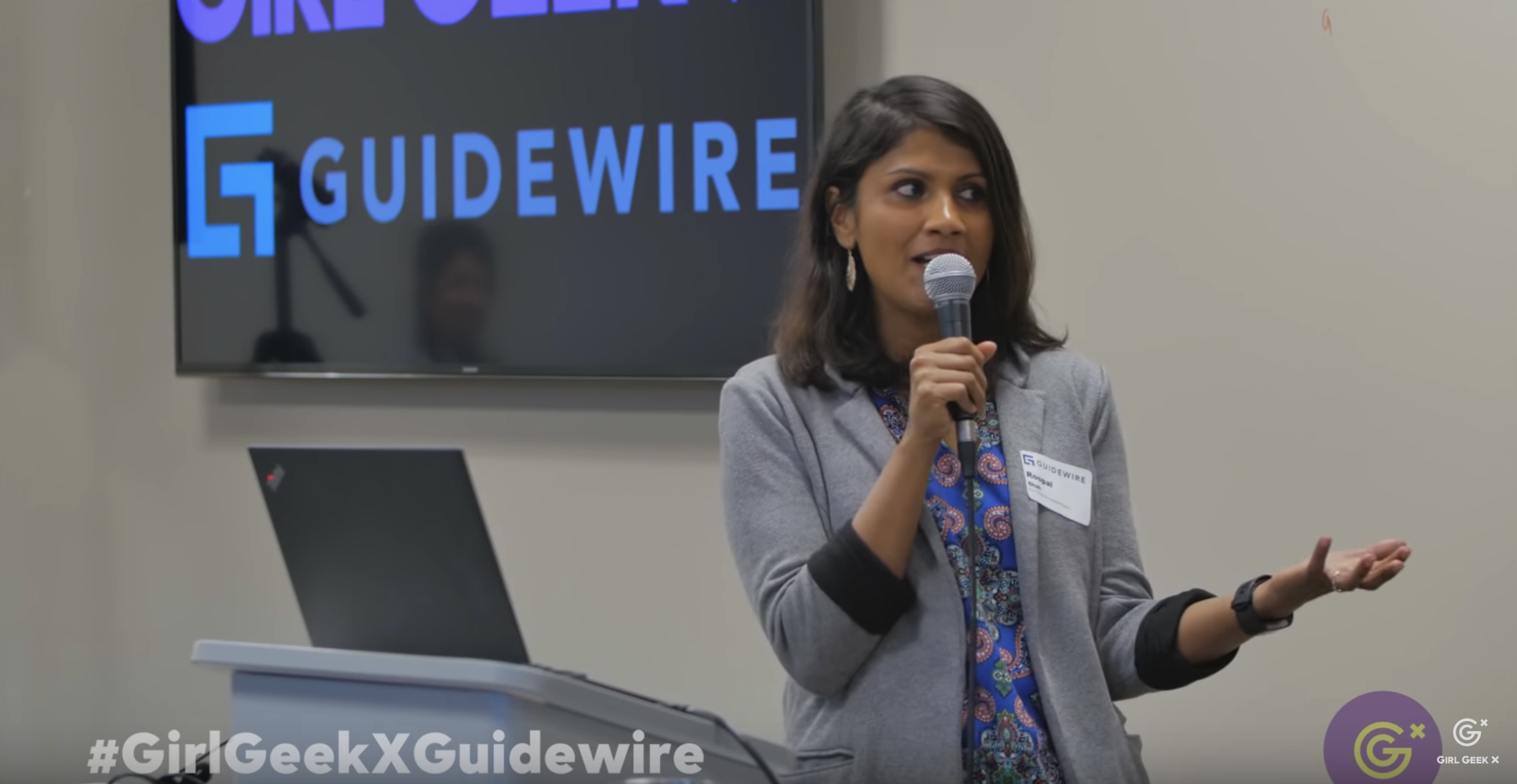
Roopal Shah speaking at Guidewire Girl Geek Dinner.
Roopal Shah: I would have loved to have things to make. You guys have any questions, concerns?
Eileen Maier: There’s one right here.
Roopal Shah: Mic?
Audience Member: Hi. I can hear you. Yeah. Hi. My name is Vera. I’m early in my professional life. I, too, work at Oracle, first job out of college. I’m currently working in online business sales and I’ve been passively or actively looking to move into another line of business. Sales just hasn’t been for me, but I’m struggling quite a bit. I get calls and emails from recruiters for sales positions but not product marketing or product management or customer success, or other things I’d consider. Do you have any advice from your experiences transferring lines of business?
Eileen Maier: Yes. I think that if you have sales experience and you’ve been out with customers and you have had difficult conversations because selling is not easy. Selling technology is actually very, very hard. You’re facing a very skeptical audience. I think that you have incredible understanding and empathy for what that sales process is like. I
Eileen Maier: think that there’s a ton of jobs out there in what’s called sales enablement and actually going in and saying, “Okay, I’m going to go inside the company but I’m going to think about the processes of what it takes to actually scale messaging,” because you know what it is that the sales team needs in order to be effective. Big marketing decks that have value propositions that start talking about the company first.
Eileen Maier: That doesn’t actually help you sell. You can come in and you can help organizations understand how do I actually make my sales team more effective? I know that there’s a huge hunger within the industry to actually be able to fulfill that. People typically go into marketing jobs and stuff.
Eileen Maier: I think that, given your experience, that’s a really good transition. I think one of the people that you should talk to, after we get done, is this woman over here because she worked with me but it was really her hard work that instituted sales enablement here at Guidewire. I think that we could probably give you a little bit more insight of some other things you could be thinking about, but that would be something I would think that would be worth you exploring.
Roopal Shah: I think there was another question. Yeah?

Girl geek asking a question to the panel at Guidewire Girl Geek Dinner.
Audience Member: My question is similar. I’m actually in sales enablement and I have a pretty diverse background but I want to scale back into marketing and I’m finding that, because my background is so diverse, it’s hard for me to market myself to a particular skill set. How should I go about doing that?
Eileen Maier: Okay. I feel like Roopal should start to answer some of these questions, too. With sales enablement and you’re thinking about going into product marketing or more corporate marketing or …
Audience Member: Corporate.
Eileen Maier: More corporate marketing. Yeah, I actually think that … I’m going to now reverse it but say the same message, which is I think the most important thing is to have empathy for the audience that you’re trying to communicate to. I think when there’s the corporate marketing mandate and what we’re trying to do in terms of increasing brand awareness and do demand generation or just brand establishment, I think that you’re doing it on behalf of the sellers who are out there in the field.
Eileen Maier: I think using maybe that angle of understanding the audiences that you’re trying to deliver value to, I think is really important because I think often times corporate marketing can get a little bit hung up in the brand and the message and lose sight of the connectivity to the people they’re trying to communicate to.
Eileen Maier: Again, going back to what I said about presentations. There’s always two sides to communication. Think about what advantage you bring, what experience you bring in terms of understanding the dynamics of that conversation because I think that you do have something special, having been on this sales enablement side.
Audience Member: I think that interesting observation during the corporate…
Roopal Shah: It might be working.
Audience Member: It’s impressive staying with the company 10, 15, 16 years, which is rare in the Valley not just from a startup perspective but the fact that you stayed with the company. I stayed at Cisco for 14 years. That does not looked very nicely. There’s a negative connotation. “Oh, you stayed too long. You didn’t change,” but then when I look at my career, I started in engineering, went to business, then went into marketing. I’ve done sales enablement. I’ve been through that journey and I lived globally, which has enriched my experience even further given the opportunities I had.
Audience Member: I’m just curious. Two questions. One is it seems like Guidewire did the right thing, at least from a diversity perspective. Seems like they retain all of you for all these years and encouraged your growth. What was the culture like with the founders?
Audience Member: The second question is how do you address the perception issue, which is completely opposite of what we see right now? Any advice or generally think?
Priscilla Hung: Maybe I can take a stab at that.
Eileen Maier: Sure.
Priscilla Hung: There a couple of things. Your observation is spot-on. I would like to go back to your first question first before we address the culture. Of course, we have a very, very strong culture in the company that we really live by. It’s not just marketing slogan. We really believe in collegiality. We really believed in working amount equals. I think that one of the reason why we stay here so long is I think, I don’t want to speak for all of you, but we genuinely are working among friends. We generally believe in the mission of the company.
Priscilla Hung: Also the company is in the last many years, it’s been doing very well progressively. We’re all proud of being the founding building blocks of it. This company really allow a very basically open view for all of us who developed. We all come into different job and end up here in a complete different job and in high places.
Priscilla Hung: It is an environment, an openness to so focus on not what you look like or what gender it is but it’s purely on how hard you work, are you a good worker, and you got recognized. Also, in my particular situation is, I don’t have a lot of experience in doing a lot of things but it’s so progressively I added more and more to my plates because my boss believed in you a competent person, a lot of the problems are … And, in fact, I think I can generalize it. It’s unlike you’re like a rocket science or you are doing something very specific. I think that going to school, it’s a lot more difficult than working.
Priscilla Hung: In fact, in working, it’s every day is your general competence and general problem-solving can go a long ways, of course, with hard work and dedication. The other thing is really dealing with people. A lot has to do with people, people communication. You work with people. I think that Guidewire paved a very, very good foundation for all of us who thrive and not just us, as all our male colleagues as well.
Priscilla Hung: But go back to the negative connotation as, “Hey. If I apply for another job, you’ve been here for 14 years,” but I think it go both ways. If I’m interviewing for someone right now who want a job at Guidewire and that person has stayed 18 years in a stagnant company, has a poor reputation, bad culture, going nowhere and you look at the progression of the companies, within the company, that person goes nowhere. Then, that is a negative thing but if you are looking at a company that has a reputation like Guidewire or other places that is small and going very big, it’s a is a very attractive profile.
Priscilla Hung: I think you have to put things in context in terms of what you mean by you’ve been a dinosaur in a company for a long time. I think the brand of the company and what it represents makes a difference in terms of the perception.
Sandia Ren: Yeah, and I would add to that, that when we’re recruiting, if I see a lot of short stints, that actually can concern me, maybe just because we’re used to people sticking around so long but it’s certainly something that I will ask is because at Guidewire, we do, we invest a lot in people. We all like each other. We want people to stick around and find their career in growth opportunities within the company.
Audience Member: I realize I’m in the audience but I think … I was at Guidewire for five and a half years, left for three and a half, just recently came back. The reason that I came back was because of the people on this panel and Guidewire cultural integrity. It really is a family environment.
Roopal Shah: Here, here.
Audience Member: Okay. I have a question.
Priscilla Hung: Oh. You’re…
Roopal Shah: Lisa Walsh, our Vice President of Alliances. There you go.
Audience Member: And anyway. You guys all talked about the importance of relationships and people in your careers. What do you look for, someone that you choose to mentor? Sort of like start to pay back. What are the attributes of someone that you think could be a good mentor, that you would like to mentor?
Sandia Ren: I can take that. Actually, as I mentioned, I was just in K.L. We were looking for a manager for the office and we were interviewing, met a number of a number of candidates who had managing teams for 10, 15 years, built teams from scratch, et cetera but then we met this girl or, I should say, woman. This woman who was … She even called herself a new leader. She’s only been managing team for a two and a half years but, as I talked to her, I could just tell that she was really smart, really clued in.
Sandia Ren: She really quickly picked up on the things that we were talking about. She was really excited to learn. She says she wants to switch jobs because she wants to be exposed to more people, different people because she thinks that that’s how she’s going to learn. I could tell the ambition was there and just the openness to learning.
Sandia Ren: Now, I’m like, “How do I hire her,” even though she may not be the best fit for what we’re looking for but it’s that eagerness to learn, that passion, I think that goes such a long way.
Lerk-Ling Chang: Yeah.
Priscilla Hung: I mean, for me, it’s just to build on that a little bit. I think, for me, it’s the chemistry has to work because I really believe in mentorship because I owe my career to my mentor, but first of all is you can’t mentor 200 … I mean, it’s the time with issue. I think that when you click, you click. Also, the second thing is just like Sandia said is, you will get a sense that whether the person in front of you actually is open due to change. If there is closeness there, it’s a waste of time.
Eileen Maier: Thank you, because we’ve been talking about this, Lisa. I think one of the things that’s really important is people say, “Well, you know, I’d like to find a mentor,” and, “It’s so important to find a mentor,” but I think this is probably the most important thing you need to know is that you actually get chosen. You can ask somebody to be your mentor but you are going to get chosen. It’s really how do you represent yourself as somebody who’s open?
Eileen Maier: You’re whip smart. Show that you’re whip smart but recognize that that’s how the relationship is going to happen is that you’re going to get chosen by that person because I think that if we think about people that we’ve mentored, it’s because that connection happened.
Eileen Maier: Make yourself available to those people that you’d like to mentor you and see if you can establish that connection in somebody’s … I guess I’m also saying you have to earn it.
Roopal Shah: I think we have time for … Okay. We’ll take these two as the last two. Do you need a mic?
Audience Member: Thank you. I’m really happy to have heard stories from all of you because just today I was feeling a little bit … “I’ve been at my company for 13 years. Am I considered a dinosaur?” Now, I don’t feel so bad because, like you said, I’ve done four different roles at the company. I know I’ve grown with the company. Thank you.
Audience Member: As a new manager, we were doing more focused on execution and planning. As I grew into a director role, it’s more about strategy. What is it at the VP level and at the COO level?
Priscilla Hung: That’s a very loaded question. I would say that, as a COO … I was just joking. Who I was talking to? My memory’s going. I was talking with someone today that I’m actually not really doing much. I’m not saying I’m lazy, but on a day-to-day basis, so my job is I’m thinking all the time. My job is to think about are we heading in the right direction? If we’re not headed in the right direction, how do I direct or influence the team to go to that direction? How do I make sure that people actually work together?
Priscilla Hung: That’s my job but I’m not giving you code. I’m not writing a paper. Sometimes I’m not doing my PowerPoint. Higher you go, it’s more about overseeing people. I would just say that when you’re individual contributor, you are measured on and you probably have something tangible that you’re delivering but as you get higher and higher, that becomes probably not majority of your job.
Priscilla Hung: Most of the time is you’re really thinking you’re working with people, you’re managing people. You’re making sure that you drive productivity in your team. I would just say that you think more and you work less. You produce less from the perspective when you get into more senior position.
Like what you see here? Our mission-aligned Girl Geek X partners are hiring!
- See open jobs at Guidewire and check out open jobs at our trusted partner companies.
- Read Guidewire’s blog post on a career in insurance: in it for the long haul.
- Does your company want to sponsor a Girl Geek Dinner in 2021? Talk to us!


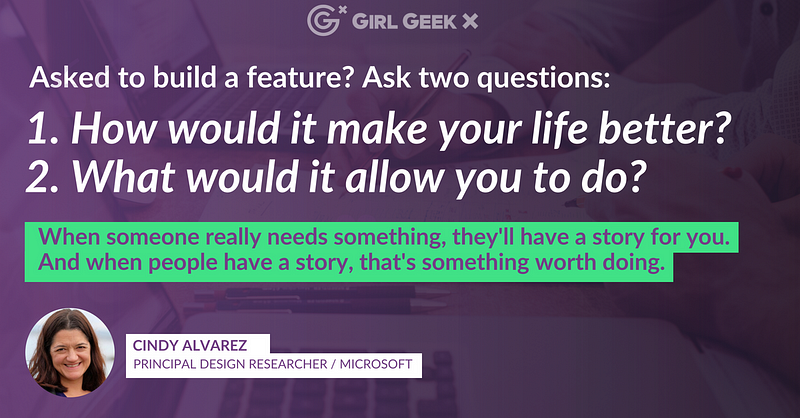
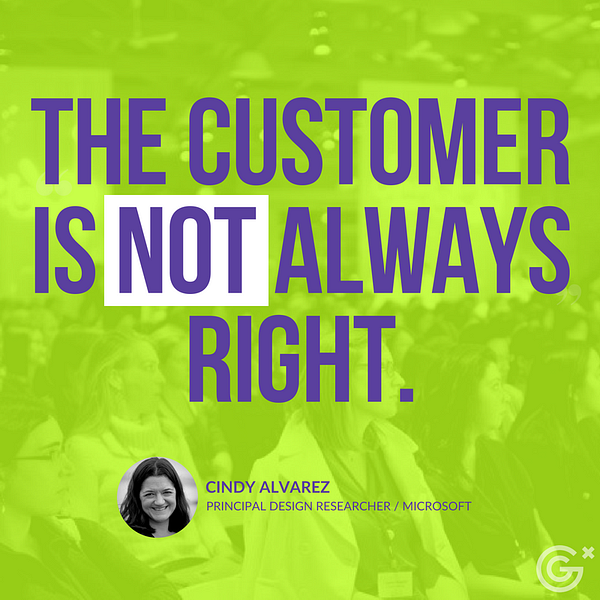
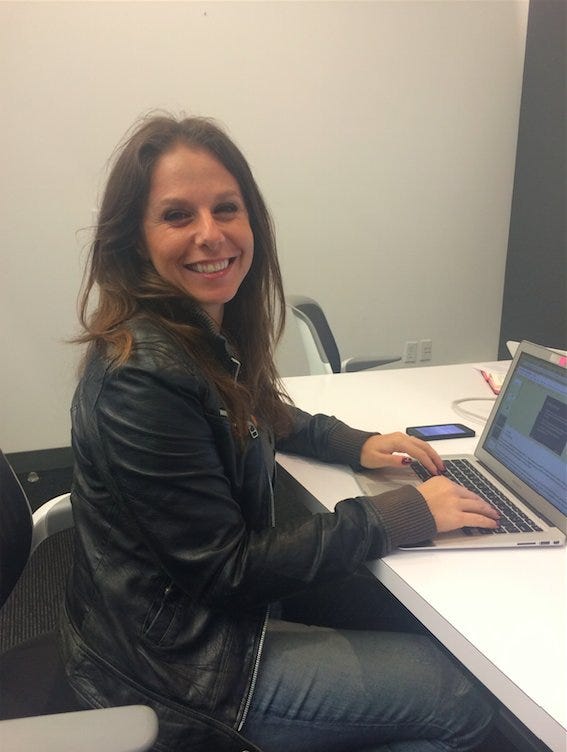


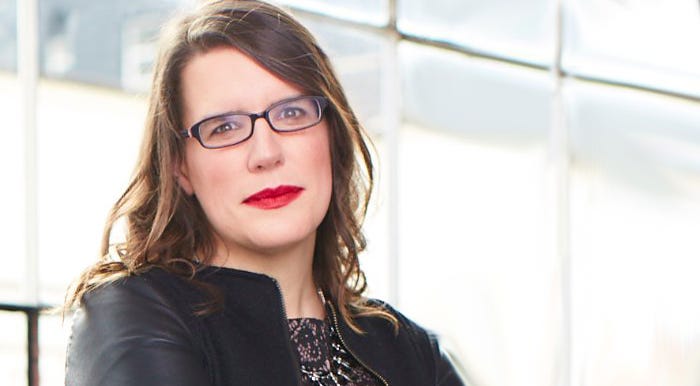
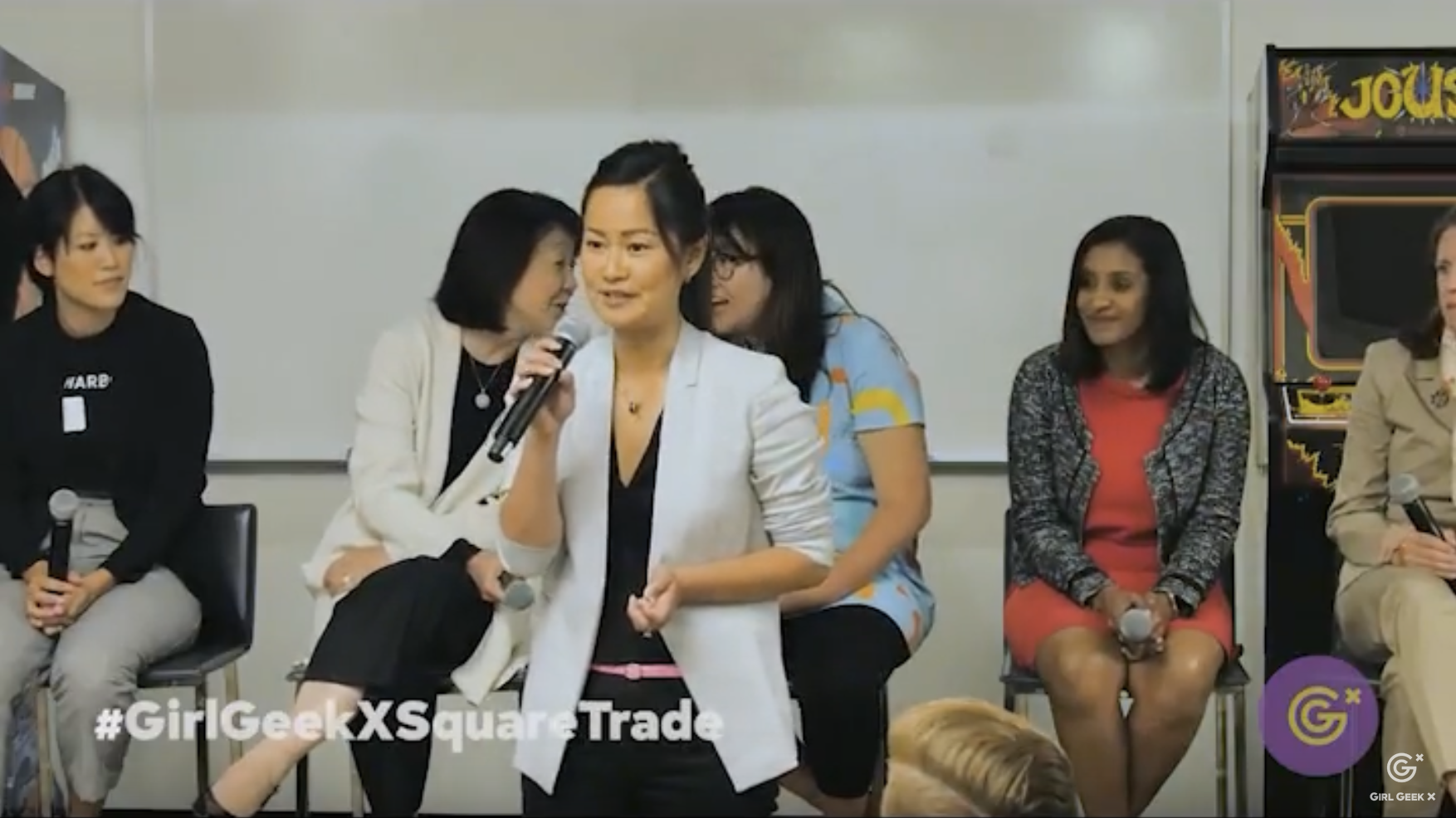
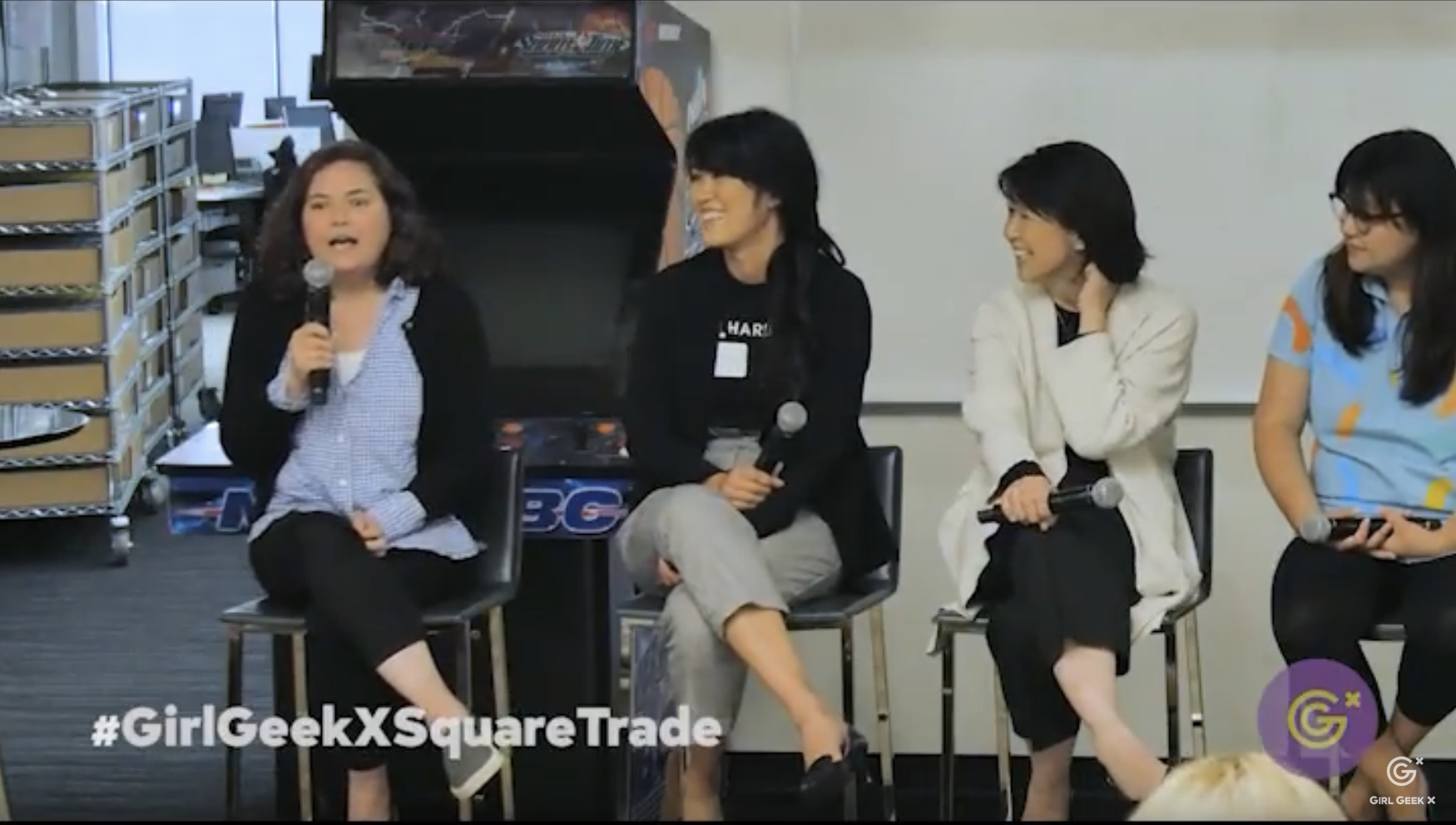
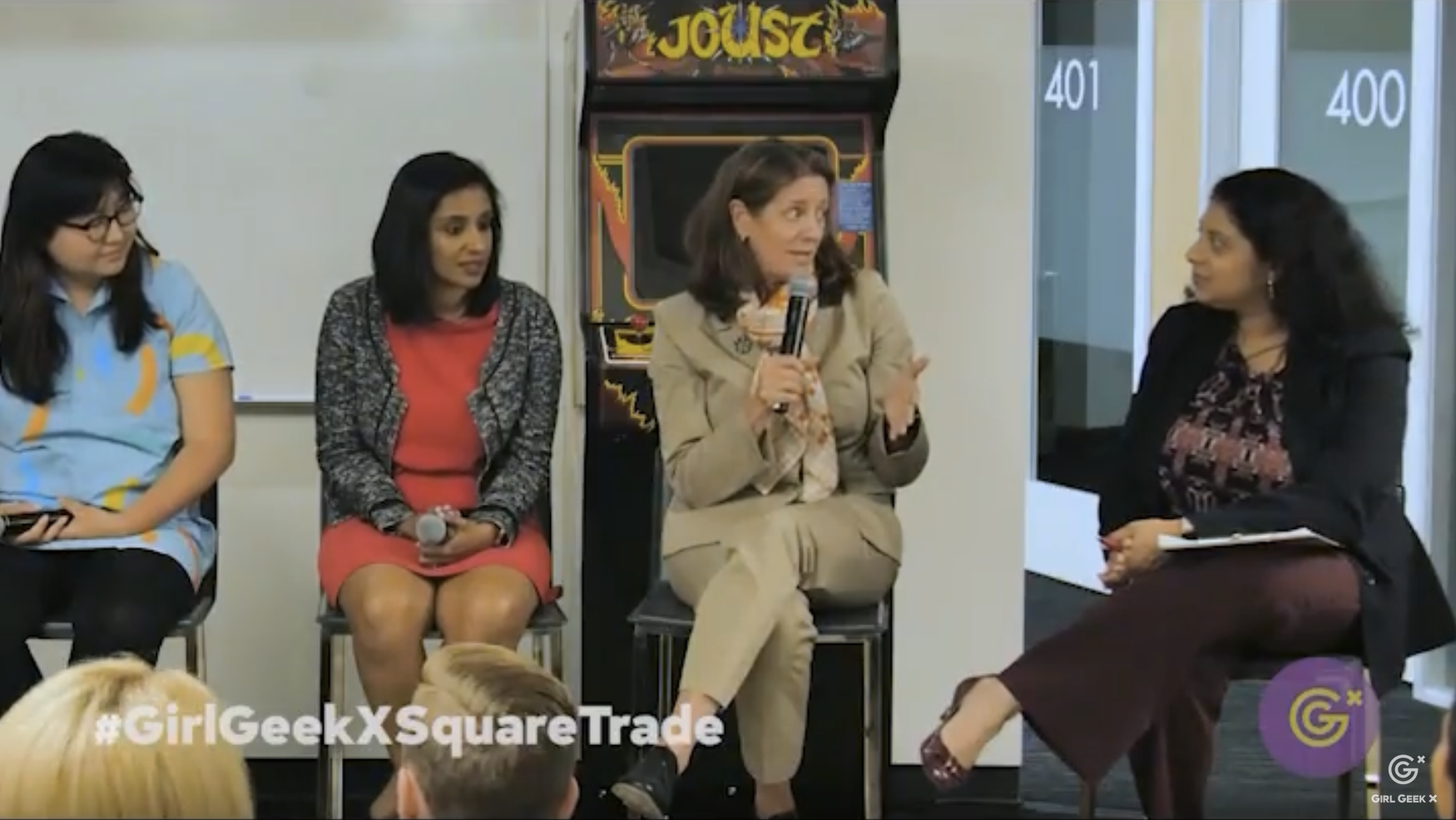
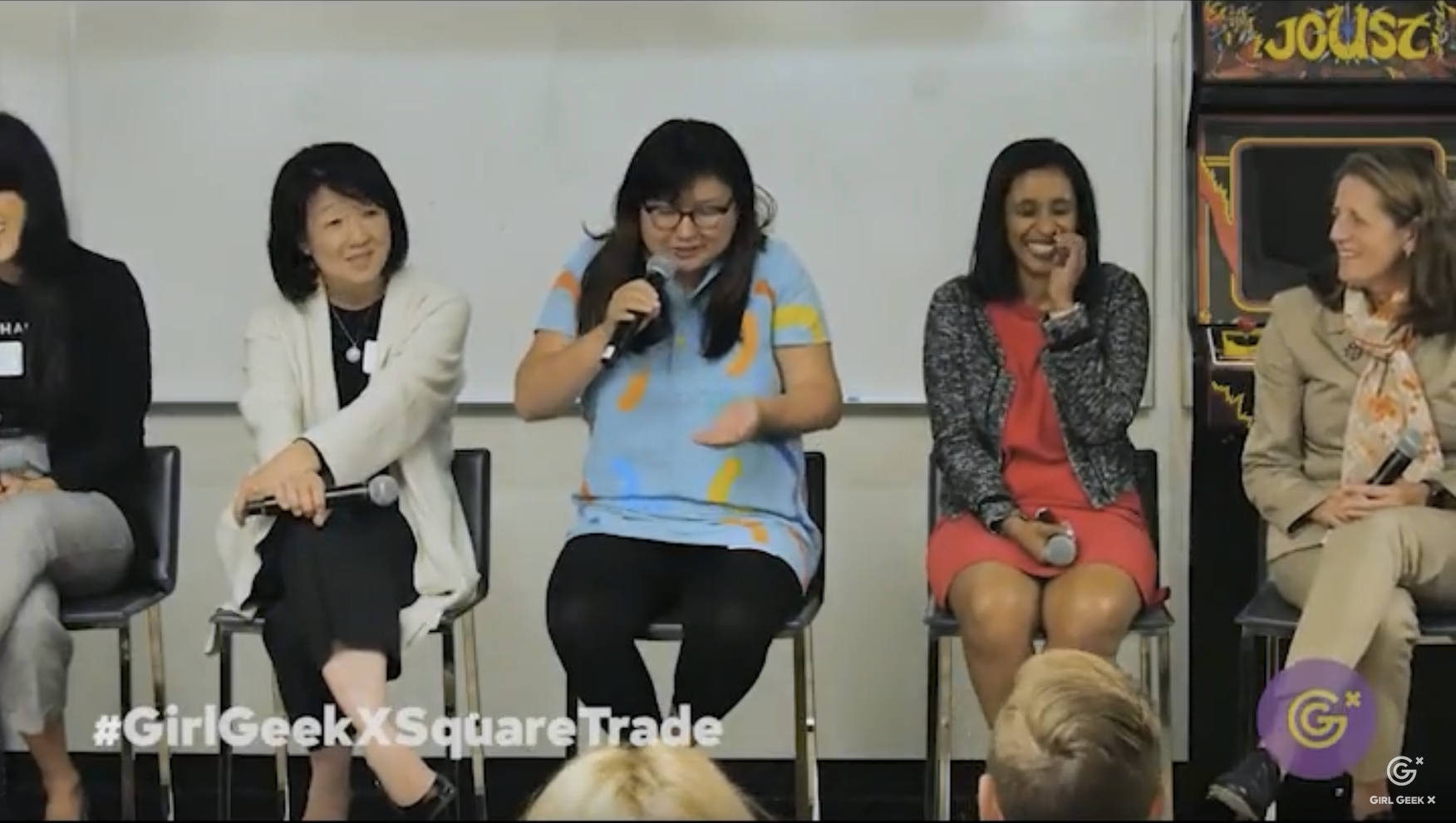

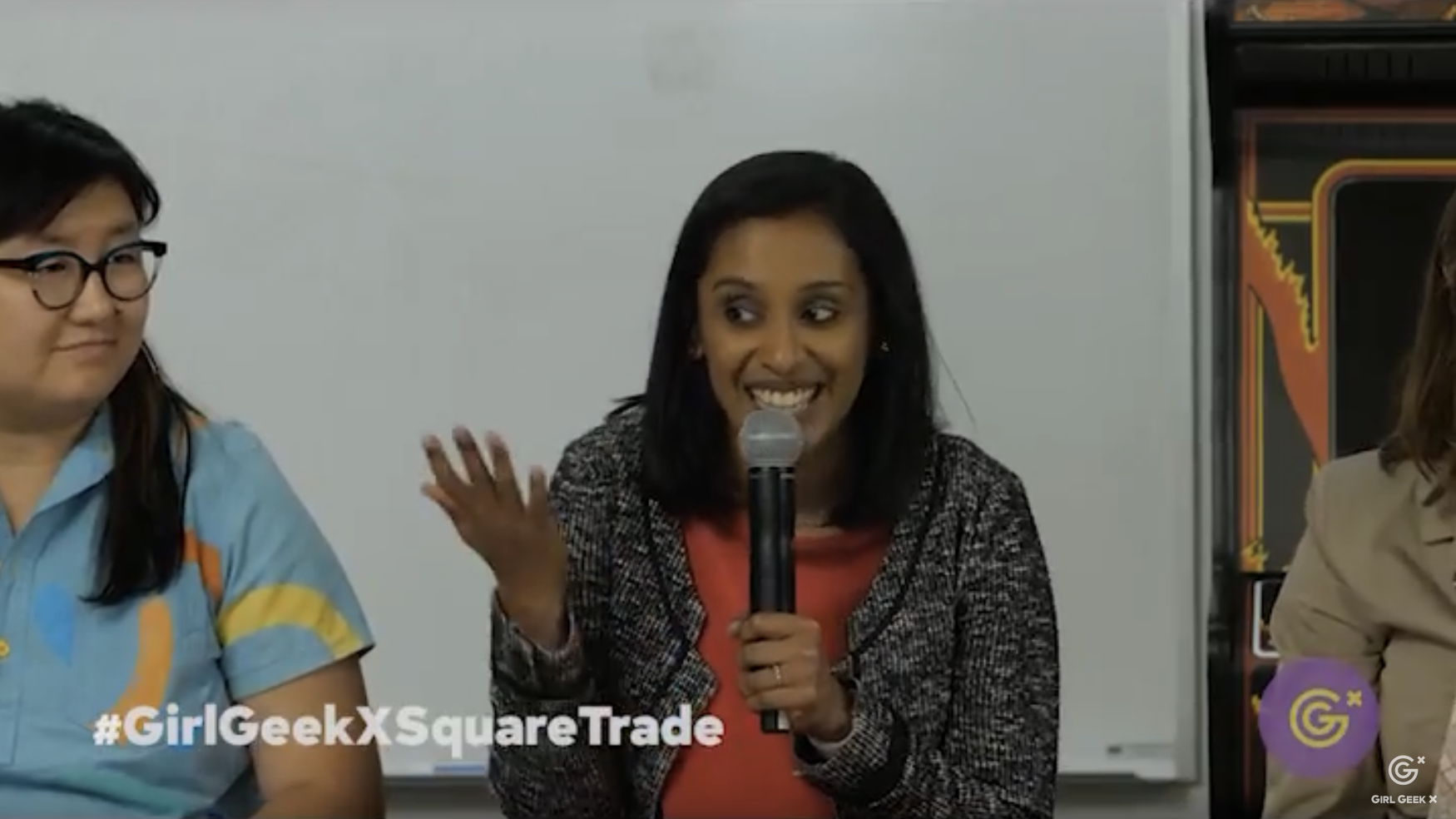
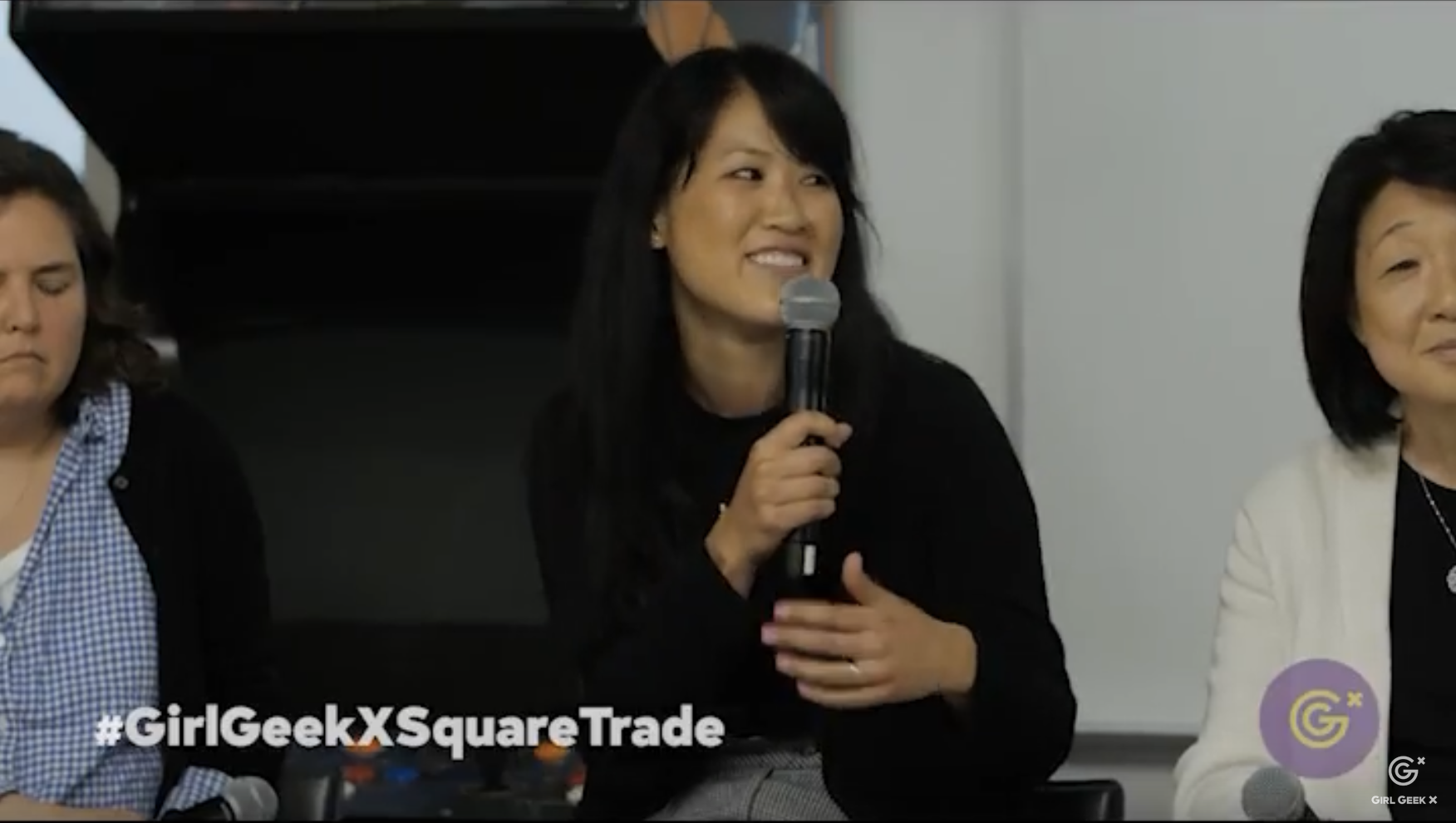
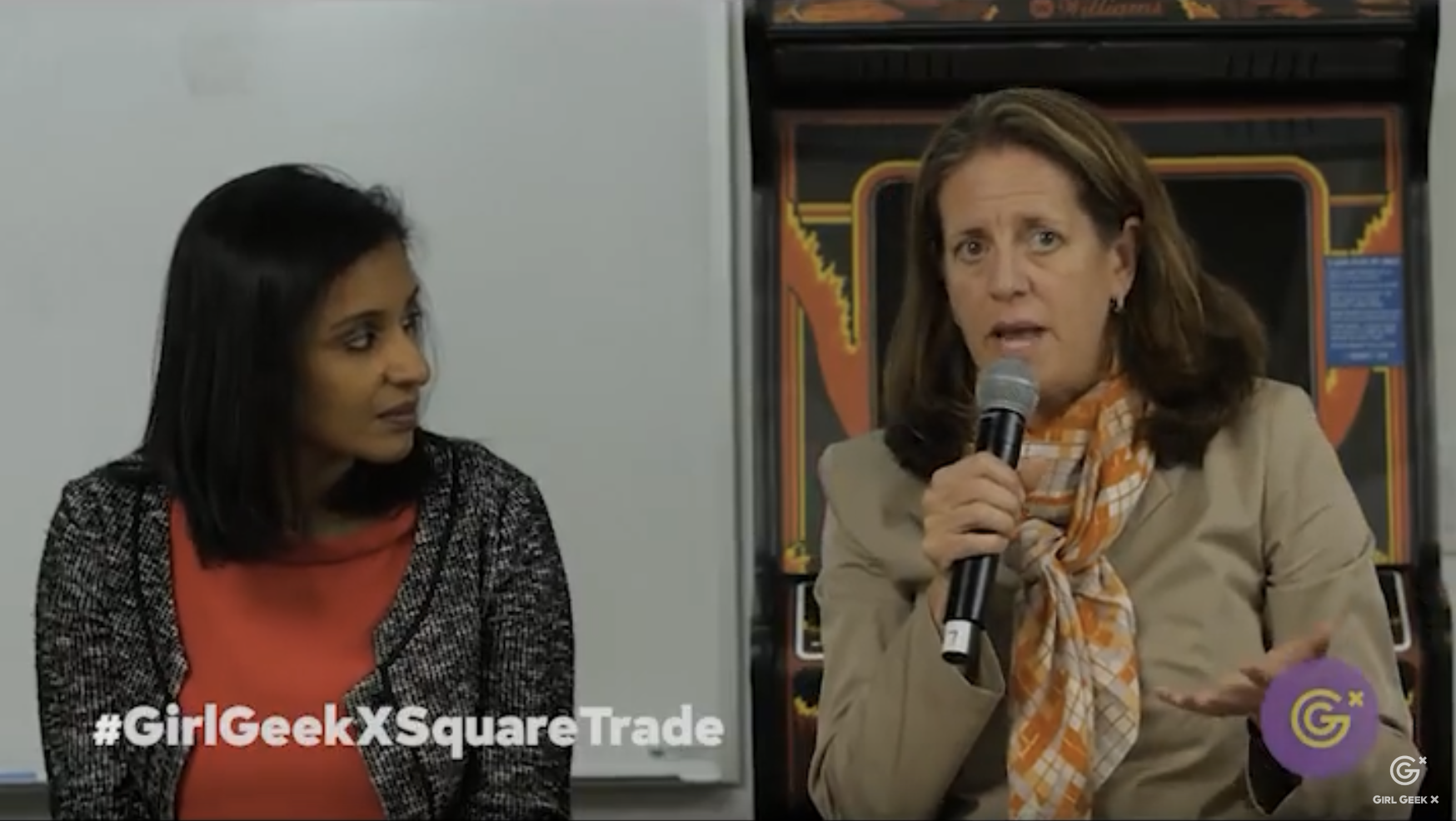
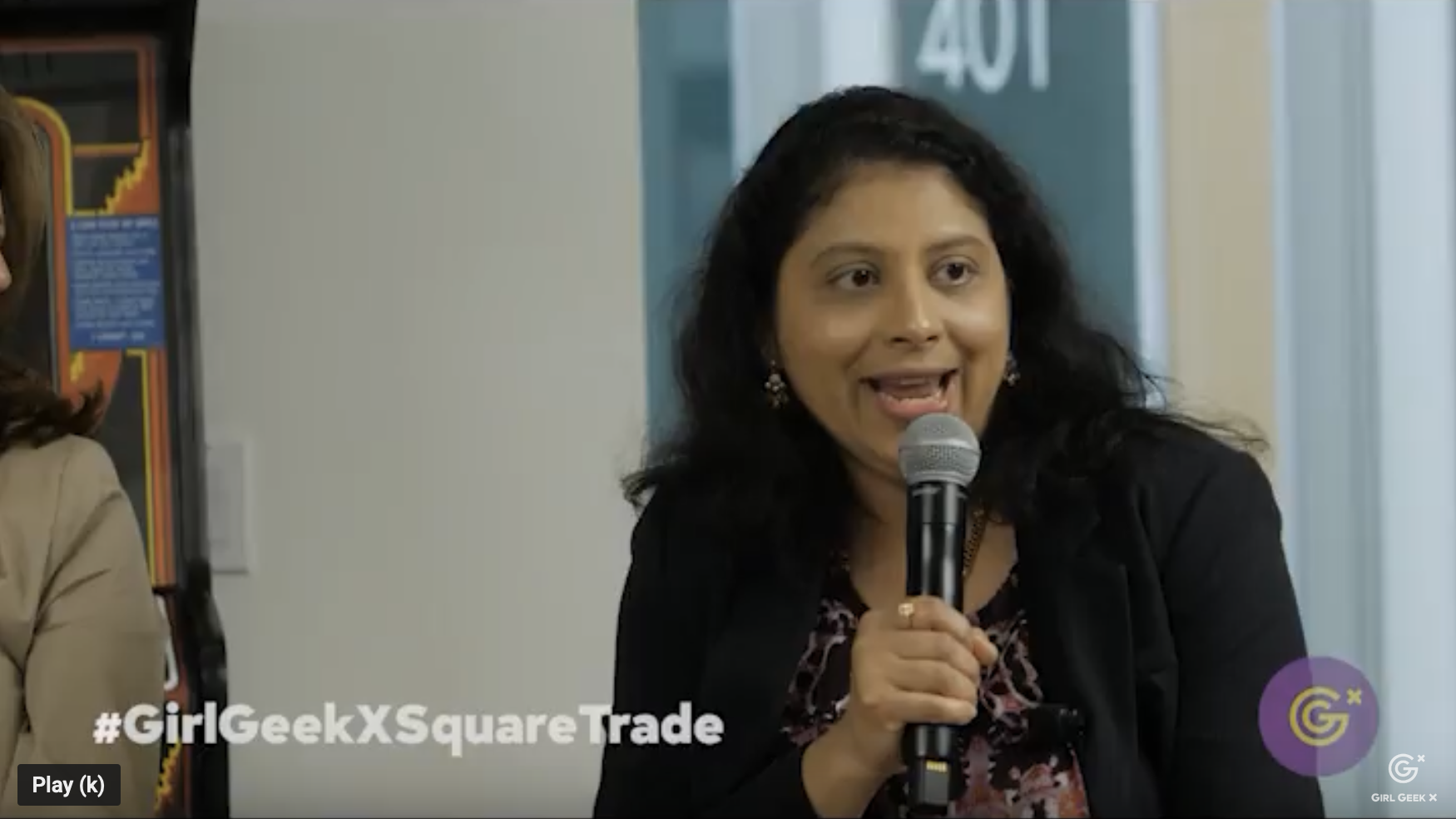 Wini Hebalkar speaking at SquareTrade Girl Geek Dinner.
Wini Hebalkar speaking at SquareTrade Girl Geek Dinner.